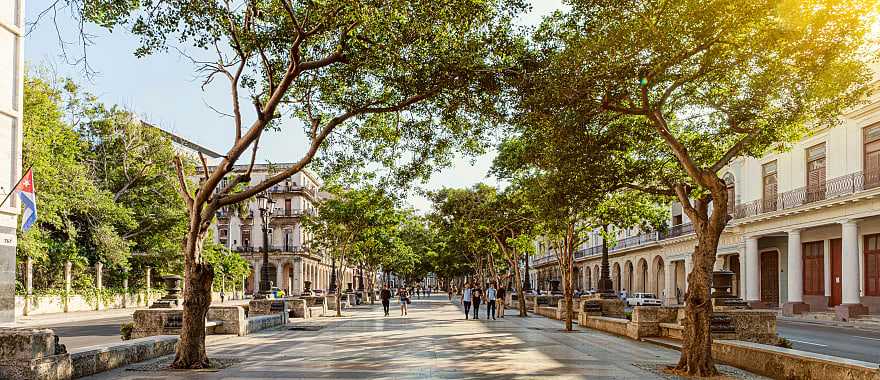

Judaism in Havana: A Tour of Jewish Cuba
Customers rate Zicasso's travel referral service 5 on a scale of 1 to 5 based on 1541 reviews on Trustpilot
We match you with top tour companies that specialize in the trip you want, whether it's a customized private tour or a group tour.
- Trip Overview
This is a sample itinerary to inspire a personalized trip designed with your travel specialist
Request a Quote
Countries Visited
Places visited, suggested duration, customizable itinerary, havana – havana heritage.
Havana is a city that captures your attention and imagination. Music spills out of cafes. Vintage American cars glide down cobblestone streets. People stroll along the Malecón and enjoy the view of the historic fortresses guarding Havana’s bay. Fishers stand atop the thick wall separating the street from the sea and cast their fishing lines into the water. The sea breeze rolls along the edges of the city, fading as it travels deeper into the old city. You land at Jose Marti International Airport with your heartbeat quickening with excitement. Your private transfer meets you at baggage claim and leads you into the bustling cityscape. The suburbs of the city contain the daily life of Havana locals.
Murals decorate walls along the roadside, celebrating the Cuban spirit. The colors resemble the blue, white, and red of the Cuban flag. Once in vibrant, contemporary neighborhood of Vedado, you pass the University of Havana. The graceful steps lead to a plateau. Stoic columns outline a noble arcade and frame a statue of Alma Mater in the foreground. The university was established in the 18th century under the authorization of Pope Innocent XIII and King Philip V of Spain. The past and the present intertwine in the city, and in the Vedado neighborhood. High-rises tower above colonial era buildings. Classic cars roll down the boulevard of La Rampa. The ice cream parlor of Coppelia turns modern day Havana into a 1950s ice cream social.
What's Included:
Havana – Embracing the Community
The morning in Vedado has a quiet rhythm. People stroll to work. Restaurants and cafes lazily open their doors. Students make their way to class, climbing stairs of the university with measured steps. You find the aroma of coconut and pineapple at breakfast. The fresh fruit reminds you of Cuba’s tropical climate. After breakfast, your guide leads you to meet with the El Patronato Jewish Community Center. A classic American car sits parked outside of the casual building.
A large arch frames the small Star of David imprinted on the center of the façade. El Patronato is home to Cuba’s largest congregation. In 2013, it sponsored athletes for the Maccabiah Games, sending almost 50 athletes to Israel to compete in the Cuban Jewish community. Spend time with the president of the congregation, along with active members of the temple to learn about the daily lives of Cubans, Cuban Jews, and the activities of the center. The community center contains a large library, and a pharmacy authorized to distribute donated medications.
In the synagogue, your guide explains the idea of the Cuban minyan. After the revolution, nearly 90 percent of the Jewish population fled. With so few people left in the country, the Jewish community instituted a new rule, counting the Torah as a qualifying member of minyan to ensure a quorum for prayer. The richness of spirit and continuation of traditions, whether unique or associated with the heritage, are inspiring. Continue to the Centro Hebreo Sefaradi in the afternoon to visit with leaders of the Sephardic community.
Havana – The Wealth of Antiques
Today you travel to the captivating center of Old Havana, framed by forts and castles. The Spanish erected Castillo de los Tres Santos Reyes Magos del Morro between the 16th and 17th centuries. It withstood attaches by French, Dutch, and English privateers throughout the ages, including a 44-day siege in the mid-1700s. Cuba’s connection to Spain casts a stark reminder of the reasons why Jewish families from the old world traveled to the Caribbean; it was an attempt to escape the Inquisition.
The past surrounds you in Old Town with a mixture of renovated colonial architecture and crumbling facades. Your guide leads you on a marvelous introductory tour of the historic buildings showcasing Cuba’s former magnificence. The City Historian’s Office has spent countless hours focused on restoring Calle Mercaderes, the Merchant’s Street. 18th-century grandeur emanates from the museums, shops, and restaurants. A needlecraft cooperative set up their workshop inside one of the buildings providing a large open space.
A small house on Calle Obrapia contains sacred objects relating to Santeria and the secret African fraternity of Abakua . During your exploration of the old city, you come to Acosta Street to find the single kosher butcher in all of Cuba. Fidel Castro wrote a special letter to the owners of the shop, allowing them to continue providing the community of Havana with kosher meat. The only orthodox synagogue in the country ensures the butchery’s upkeep and is presided over by the rabbi, cantor, and treasurer of the temple, which happens to be the same person.
Havana – Cuba and the Arts
In the suburbs of Havana, you will find the former home of award-winning American writer, Ernest Hemingway. The Cuban government has preserved the house, known as Finca Vigia—Lookout Farm, since 1960. After breakfast, you make your way on a guided tour of the home of Hemingway for nearly 21 years. The library contains approximately 9,000 books spanning the entire home, including the bathroom. The typewriter on which Hemingway wrote award-winning novels such as The Old Man and the Sea , sits atop a stand-up desk. All the windows and doors are open to provide perfect sightlines for visitors throughout the entire home, but to preserve the integrity of the museum, no one is allowed inside.
Your guide points to a ceramic bowl on a couch-side table. He explains that Pablo Picasso designed the piece and gave it to his friend. You continue to the colorful neighborhood of Jaimanitas to stroll along the artistic wonderland of Fusterlandia. Ceramic mosaics shape the walls. The surreal design resembles the enterprises of Spanish architect Antonin Gaudi. Roofs, doorways, benches, and walls span blocks encompassing more than 80 neighborhoods. Intermittent sculptures decorate the street. Courtyards provide views of ceramic dragons. Inspiration is everywhere, and the arts overtake the island in various ways.
Santa Clara – Celebrations of the Past and Present
The colors of Fusterlandia remain prevalent in your thoughts today. The bright stories the artist told lifts spirits around Havana and the world. After breakfast, you venture to the Guanabacoa Museum, dedicated to tracking the development of the Guanabacoa neighborhood through the 18th and 19th centuries. Your guide draws parallels to Jewish heritage when you see the exhibits on the Afro-Cuban culture, highlighting the history of slavery and the emergence of the Santeria religion. The mythology and ritual of the various religions intrigue you. After your exploration of the museum, you make your way to the United Hebrew Congregation Cemetery.
The grounds were established in the early 1900s. The layout holds to Jewish tradition with a space outside the gates for visitors to wash their hands upon leaving. The aligned gravestones face directly east. You find various languages inscribing the stones, from Spanish to Yiddish, Russian to English. Many of the birthplaces on the older stones mention cities in Eastern and Central Europe. The grounds are unique due to their location and history. Continue to the small fishing village of Cojimar, where Hemingway set the storyline for The Old Man and the Sea .
Santa Clara – Discovering Trinidad
Trinidad has an ineffable spirit unlike any other city in Cuba. Afro-Cuban culture remains strong, deeply rooted in the history of the sugarcane plantations located near the city. Colonial buildings glimmer with pastel colors. Horses trot down the cobblestone streets, passing through the shadows cast by former churches. After breakfast, you make your way to the UNESCO heritage site to experience the culture of Trinidad. Red-tiled rooftops slant toward the narrow roads. The Spanish settled the city in the 1514 and built an elaborate sugarcane industry in the valleys opposite the rolling Escambray Mountains.
Enter into the Casa del Alfarero, a pottery workshop sharing the tradition of pottery in the city, which dates back to the 19th century. Partake in a class to learn the secrets of the city and the art form. The knowledge of pottery work has been passed down through the generations. You get your hands involved with wet clay, shaping and guiding the form until it reaches a design you prefer. Locals have modeled the clay to tell stories of their past and the history of the city. After your work gets placed in the kiln to dry, you follow in the footsteps of the locals and visitors to discover the heritage of Trinidad. Begin with a visit to the Museo de Historia Municipal, which exhibits spectacular objects from wealthy families located inside a grandiose edifice in the Plaza Mayor.
Santa Clara – Life in Santa Clara
A rebellious spirit fills the streets of Santa Clara, inspired by the local university and the large student population. The Che Guevara monument fosters the local ideology of questioning authority. Spend a part of your day visiting the local Jewish Community. In 2007, the 25-member-strong community had gathered enough funds to buy a home and convert it into a synagogue. A Holocaust memorial erected in 2003 lies adjacent to the Jewish cemetery. The museum contains a stone from the Holocaust Memorial Museum in Washington D.C. Stones from the Warsaw Ghetto pave the path leading to the entryway.
Locals like to connect the uprising of the Warsaw Ghetto to the spirit of the Jewish people in Cuba, especially in Santa Clara, where the people are always willing to fight for their beliefs. A menorah with six branches symbolizes the six million Jews who died in the Holocaust. Your guide leads you through the city to the Che Guevara Memorial. A large bronze statue of the revolutionary guards the entrance to the square. A mausoleum contains 38 carved niches dedicated to the guerillas that fought for Bolivian independence. You can hear horses carrying visitors down the main road around the edges of the elegant monument.
Cienfuegos – A Lasting Image of Beauty
In the morning, you remember the words of a song you once learned at the synagogue. “Wherever you go, there’s always someone Jewish.” You can’t help but repeat the lyrics in your head before breakfast. You have not only set foot in Cuba, but followed in the footsteps of Jewish communities that have fled persecution for hundreds of years, from Spain to Russia, and even Germany. Your private transfer greets you at the hotel after breakfast and escorts you to the charming city of Cienfuegos. Red-tiles outline cupolas adorn pearled buildings erected by 19th-century French settlers. The bay sparkles four different shapes of blue. You board your flight and watch Cuba fade away beneath you, enjoying the spectacular final panorama of a country cradling a unique Jewish heritage.
Trip Highlights
- Visit with the various local Jewish communities across Cuba, from Sephardic to Ashkenazy, in Havana and Santa Clara
- Partake in a pottery workshop that immerses you in the cultural artwork of the spirited Afro-Cuban colonial town of Trinidad
- Discover the history and multi-cultural grounds of the Havana Jewish Cemetery
- Experience the extraordinary past and present of Havana’s artistic community with a tour of Hemingway’s former home and the remarkable neighborhood known as Fusterlandia
- Visit the Holocaust Museum in Santa Clara, which contains a walking path paved by stones from the Warsaw Ghetto
- Traverse the shop of the only kosher butcher in all of Cuba, located in Old Havana
- Enjoy a guided tour of Old Havana where the footprints of Spanish Jews escaping the Inquisition are as poignant as the synagogues that remain in the city
Detailed Description
No matter where in the world you travel, you can celebrate the week’s end with a member of the Jewish community and feel like family. Your 8-day tour of Cuba introduces you to the unique life of Cuban Jews, from their struggles of continuing traditions to their history of family perseverance. You arrive in Havana for an introductory tour of the city, beginning with a visit to the Plaza de la Revolucion. Settle in the luxurious neighborhood of Vedado, home to some of the finest hotels in all of Havana. The next day, you meet with members of the Jewish community learning about the religious school system, along with the exploring the different synagogues around the city.
Follow your guide on a fabulous tour of Old Havana. Make your way to the orthodox temple and visit Cuba’s only kosher butcher. Discover the thriving art scene of Cuba by venturing to Finca Vigia, the former home of Ernest Hemingway. Continue with a tour of the spectacular neighborhood of Jaimanitas, also known as Fusterlandia, named for the artist who turned the streets into a ceramic wonderland. Next, you venture to the Guanabacoa Museum for an introduction into the eastern suburb of Havana. Stroll through the Jewish Cemetery before arriving in the charming fishing village of Cojimar.
Your private transfer escorts you to Santa Clara, where you meet the local Jewish community. If you arrive on Shabbat, you can partake in dinner and the traditions of the city. The next day takes you to the preserved colonial town of Trinidad for an interactive cultural experience. Enjoy a pottery workshop before touring the historic streets. Then, you explore the spirited ambiance of Santa Clara. Make your way to the Holocaust Museum followed by a tour of the colonial houses and remarkable monuments decorating the city. On your final day, your private transfer escorts you to the airport in Cienfuegos for your flight home.
Consider browsing our other tours to Cuba to gain further inspiration for your dream Cuba vacation of a lifetime.
Starting Price
$3,379 per person (excluding international flights)
Your Zicasso trip is fully customizable, and this sample itinerary is a starting place for your travel plans. Actual costs are dynamic, and your selection of accommodations and activities, your season of travel, and other such variables will bring this budget guideline up or down. Throughout your planning experience with your Zicasso specialist, your itinerary is designed around your budget. You can book your trip when you are satisfied with every detail. Planning your trip with a Zicasso travel specialist is a free service.
What's Included
- Accommodations
- In-country transportation
- Some or all activities and tours
- Expert trip planning
- 24x7 support during your trip
Your final trip cost will vary based on your selected accommodations, activities, meals, and other trip elements that you opt to include.
Reviews of Zicasso's Referral Service
4.98 stars based on 90 reviews.
Reviewed By Lauren F.
Reviewed By Cassandra C.
Reviewed By Matthew C.
Reviewed By PATRICIA B.
Reviewed By Robert A.
Reviewed By Sandra E.
Expert Tips for Discerning Travelers
Your Dream Vacation
in 3 simple steps
Describe your dream trip
Get matched with top travel specialists
Book the trip
Help Me Plan My Trip
Free service - no credit card required

- LET'S TALK
- LET'S EAT
- FAMILY & EDUCATION
- SOCIAL & PERSONAL
- JEWISH WORDS
- JEWISH HOW TOS
- RABBI I HAVE A PROBLEM
- EDUCATIONAL
- PROFESSIONAL
- THE FRESSER
- THE SCHMOOZE
Sign up to The JC newsletter
Havana surprise: discovering jewish cuba.
Our writer looks beyond the cigars and salsa to discover the secrets of the Cuban capital
BY Brian Levy

Be prepared to expect the unexpected in Cuba, we’d been told. And with its less well-known Jewish heritage behind the brightly coloured façade, Havana certainly didn’t disappoint.
A dignified yet dilapidated city trapped in a time warp, it boasts an extraordinary mix of narrow cobbled streets and grandiose squares, unsmiling blocks of Soviet-built council flats plonked between run-down homes with crumbling facades.
Here there are virtually no advertisements except for a handful of political billboards, music streams out from open windows and the roads are filled primarily with 1950s and 1960s vintage American cars — with our guide proudly informing us that Cuban mechanics are the best in the world!
And in a quiet residential neighbourhood in Vedado, perhaps the most interesting district apart from historic Old Havana, sits El Patronato, the city’s Jewish Community Centre.
Next door, a dozen marble steps lead to the Conservative Beth Shalom synagogue, the biggest shul in Cuba, topped with a high arch and large Magen David.
Before the revolution in 1959, there were over 15,000 Jews in Cuba. Around 90 per cent left soon after, many middle-class merchants or professionals seeking a more congenial life in America. An added spur came when atheism was declared Cuba’s national religion.
Today, the vast majority of the remaining 1,400 Jews live in Havana, a city of two million inhabitants. Despite this exodus — and Fidel Castro’s decision to break off diplomatic relations with Israel in 1973 — there has rarely been any antisemitism experienced by Cuban Jews.
Orthodox services are still held daily at the Adath Israel shul, which began life when Ashkenazi immigrants from Eastern Europe started to arrive in the 1920s to work in the garment industry, followed by refugees from the Nazis.
Nowadays the 300-strong congregation is equally divided between Ashkenazim and Sephardim. The shul proudly states that its doors have never closed and visitors are always welcome, especially for the Friday night Kabbalat Shabbat service, while it also provides a free breakfast for the often impoverished pensioners who remain.

The tranquil façade and atmospheric tree-lined streets of Vedado also house some of the country’s hottest jazz clubs, especially around La Rampa, not to mention the famed Coppelia ice-cream parlour which serves over 16,000 litres of ice cream every day.
Cruising around in a classic 1953 Plymouth convertible with our state-employed official guide, it’s simple to tailor an afternoon excursion around any particular interest.
But while the avenues with their beautiful architecture can be a welcome respite after bustling Old Havana, it’s in la Habana Vieja that you’ll find the sights which tempt most tourists, a short drive back along the famous five mile Malecon seawall.
It’s easy to explore on foot too, with time for a mojito along the way. After enjoying the spectacular views from the rooftop terrace of the swish Parque hotel with ours, we set off to wander from the Parque Central plaza.
In the centre of the square stands a marble statue of José Martí, the revolutionary poet and journalist who died in 1895 fighting for Cuba’s independence, while behind the statue you can spot the Hotel Inglaterra, the oldest hotel in Cuba where a young military reporter named Winston Churchill stayed in 1895 during the Spanish–Cuban war.
And next door stands the magnificent Gran Teatro de la Habana — the Grand Theatre of Havana — dating from 1838 and home to the renowned Cuban National Ballet.
The impressive El Capitolio, or National Capitol Building, which now houses the Cuban Academy of Sciences is closed for renovations until 2019, but it’s a splendid sight. The seat of government until the revolution, inside its treasures include the gigantic statue La Estatua de la República.
Then onwards towards the sea. A gaudy frontage of yellows, pinks and blues on the tree-lined Paseo del Prado marks the striking Hotel Sevilla, Al Capone’s haunt in the 1930s.
Or stroll the narrow streets and alleys; the most popular is the pedestrianised Calle Obispo, a bustling narrow thoroughfare jam-packed with gift shops, bars, paladares — private rather than state-run restaurants — and street vendors.
Whilst smokers might be tempted to buy from one of the women in white sitting on the pavement who always keep cigars between their lips, aficionados would do better to stock up after watching the cigars being hand-rolled at the city’s Partagas factory.

Obispo spills out onto the Plaza de Armas, a square lush with overgrown tropical vegetation as well as a beautiful ceiba tree where, on November 16, 1519, the town of San Cristobal de la Habana was founded.
Revered by many Cubans, there is a popular tradition of making wishes for prosperity on the anniversary, while making three circles around the tree, touching or even kissing it — a Santeria ritual derived from Catholic and African beliefs.
As evening arrives, the favourite place for habaneros to promenade is along the iconic Malecon esplanade itself — with the Hotel Nacional de Cuba summing up Havana’s eventful history.
This once swanky resort for Americans in the 1930s fell under control by the Mafia, hosting the Havana Conference mob summit run by Meyer Lansky and Lucky Luciano. Abandoned after Fidel Castro closed the casino, it fell into disrepair before being restored to its days of five-star luxury when Cuba reopened to tourists.
Whatever you expect from a trip to Cuba, there are always more surprises in store in this fascinating country.

Marvellous Montenegro

Nicaragua: Land of lakes and volcanoes

JC Stays: Hotel Sans Souci, Vienna

It’s a kind of magic – Orlando beyond the theme parks

Czech it out – the best city breaks in Czechia apart from Prague
Have the JC delivered to your door

Want more from the JC?
To continue reading, we just need a few details....
©2024 The Jewish Chronicle
- Advertising
- Terms & Conditions
- Cookie Policy
- Privacy policy

Havana Tours Havana’s Jewish Heritage
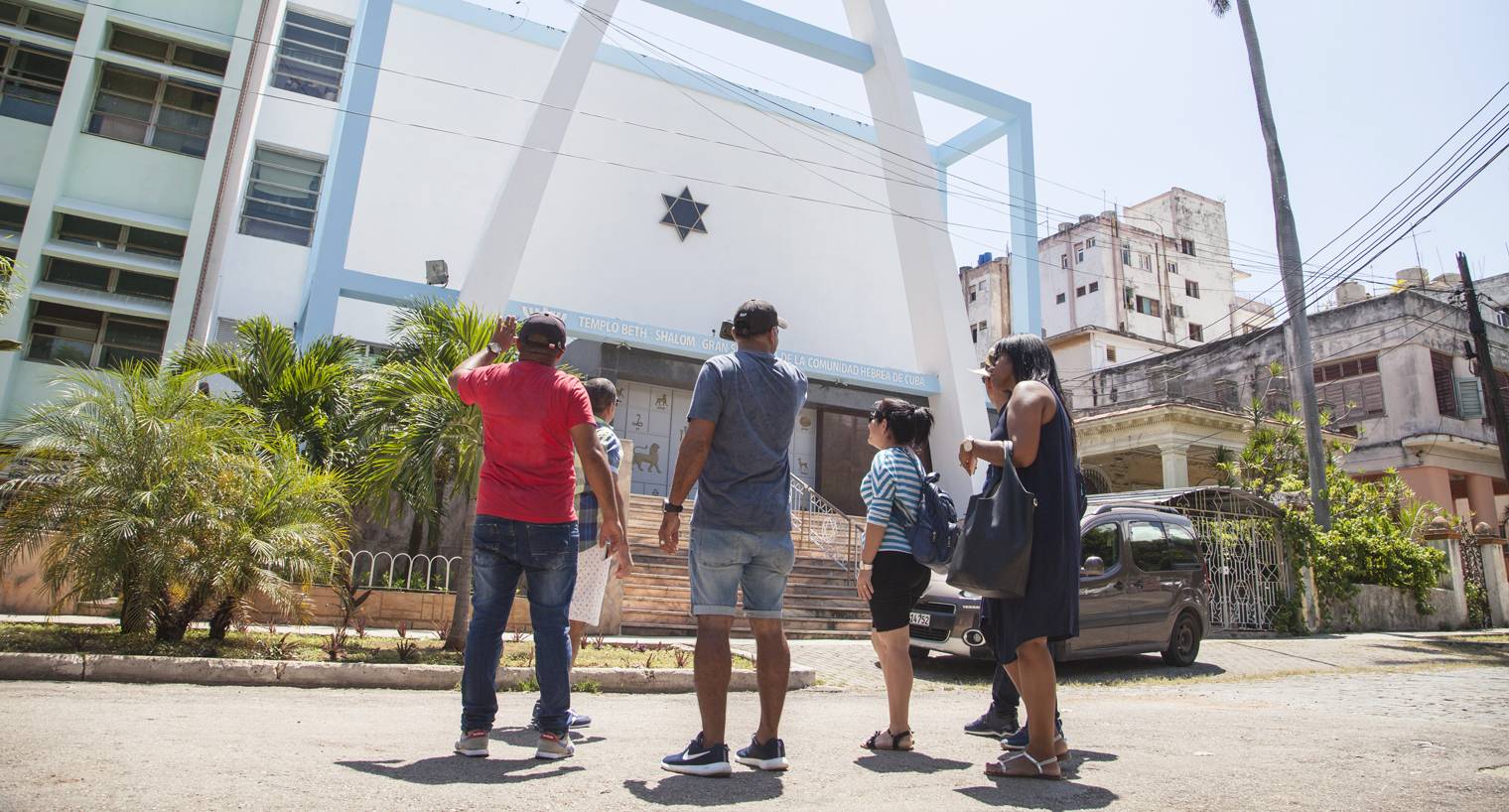
- Learn about the history of Jewish immigration in the early 20th Century
- Meet with members of the Jewish community and tour a synagogue
- Visit a special hotel that references Jewish culture with its décor
At a Glance
Detailed description.
This tour takes you through the history of the Jewish immigration and presence in Cuba.
We will meet the President of the Jewish Association in Havana who invites you into the synagogue still in use today in Vedado. We will also see another synagogue in Vedado before heading off to visit the cemetery in Guanabacoa to talk about the burial traditions and symbolism displayed throughout the cemetery. After our visit to Guanabacoa we head back to Old Havana and stop in at the Menorah Square to pay tribute to the victims of the holocaust. This square was inaugurated by Fidel Castro in June 2006.
We walk through Old Havana passing by the oldest Orthodox synagogue in Cuba, to arrive at the Hotel Raquel, a tribute to the Hebrew culture and its ongoing presence in Cuba. This ornate hotel with its baroque facade hints to a time gone by, when a predominantly Jewish neighbourhood of Old Havana once thrived. After the revolution 95% of the Jewish community left Cuba, but we invite you to experience the legacy left behind.
Ending point: Hotel Raquel, 263 Mercaderes Street, Old Havana
Legality for Americans: Services are OFAC compliant under the general license Support for the Cuban people 515.574
Child Policy: Child friendly experience
- Local Havana English speaking tour guide
- Entrance fees for activities noted
- Transport during the tour
Not Included
- Transportation from meeting point
- Additional food and drinks
- Tips/gratuities
More Havana Tours
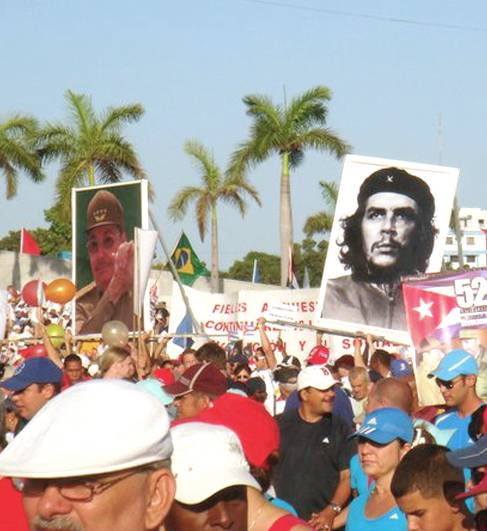
Join the May Day Parade in Havana (May 1st)
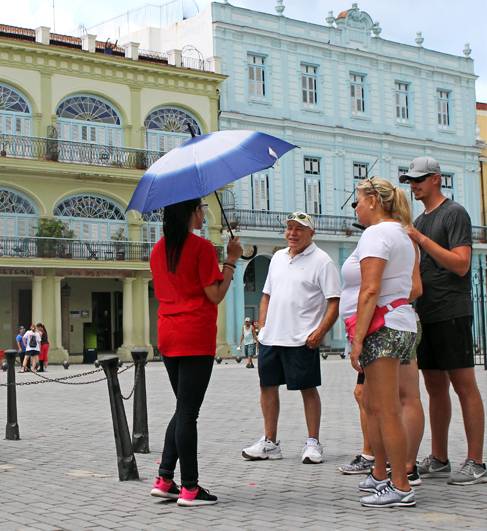
Old Havana history walk with local guide
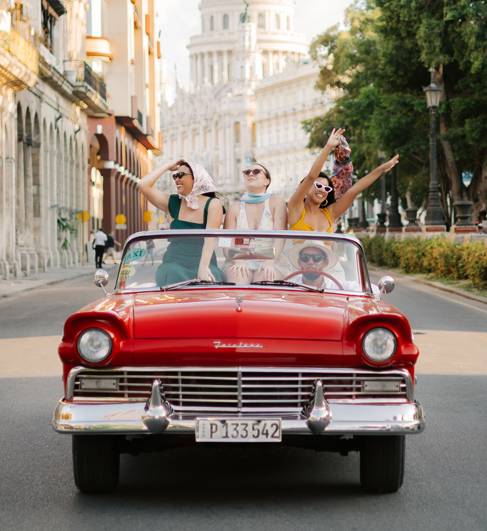
1950’s Convertible Car Tour
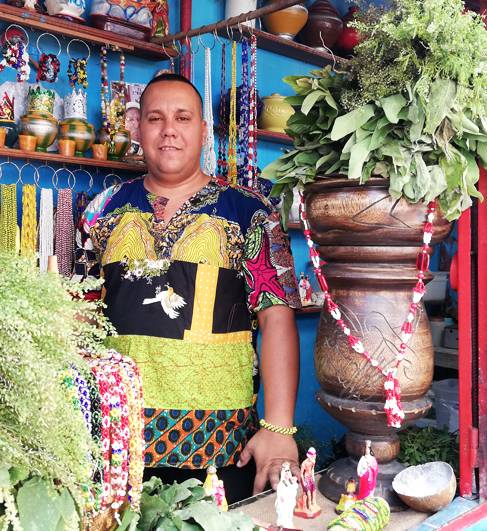
Learn about Afro-Cuban culture and religions
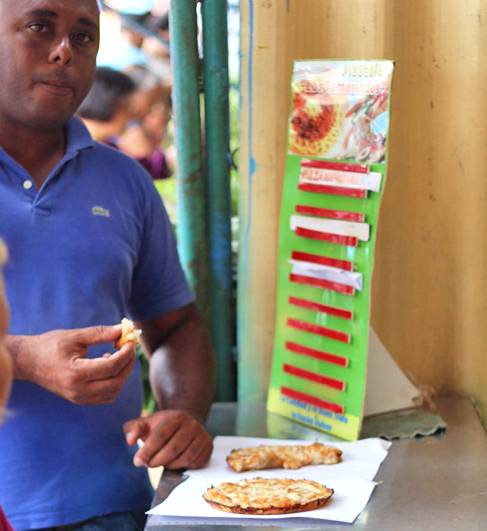
Old Havana street food experience
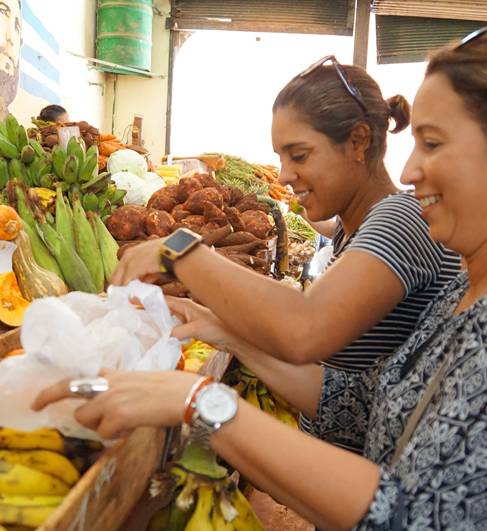
Cooking Experience with Local Cubans
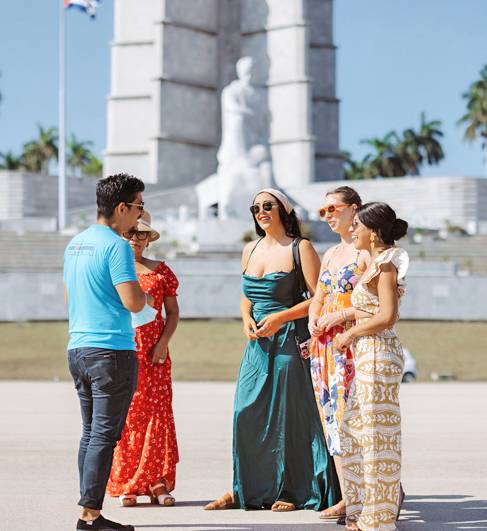
Full Day Havana Tour Package
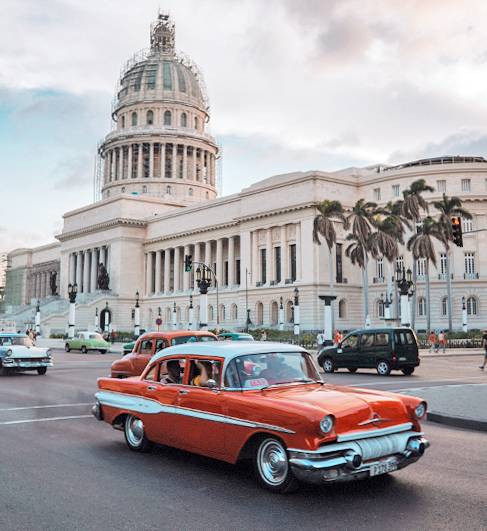
Mafia & The American Influence in Cuba

Discover Havana’s Street Art and its Artists
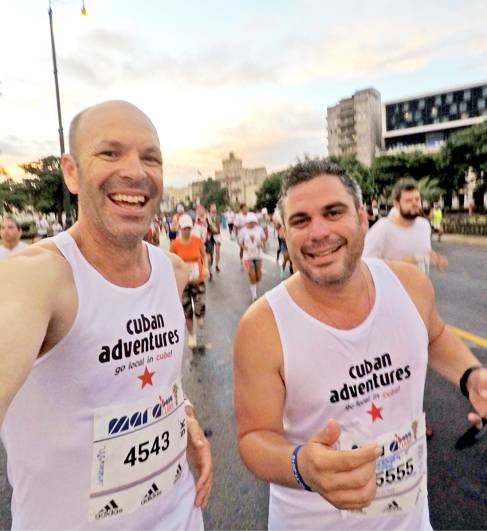
Havana Marathon Experience (November 20)

Learn about and taste Cuban Cigars
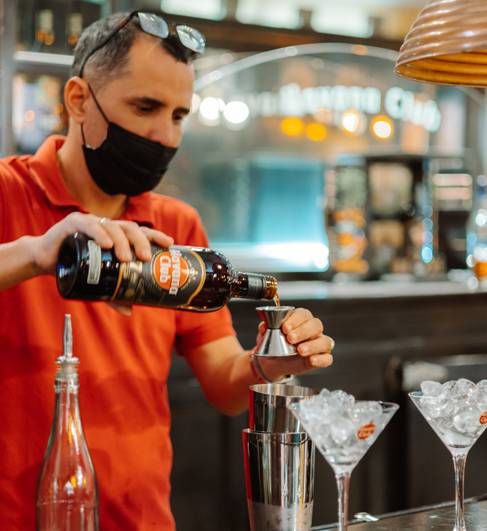
Learn about and taste Cuban Rum
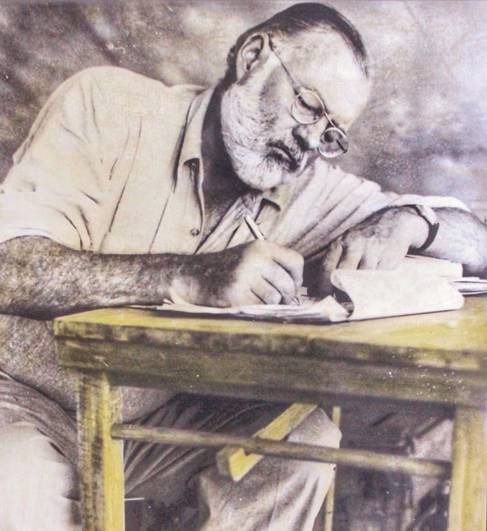
All about Ernest Hemmingway’s Cuba
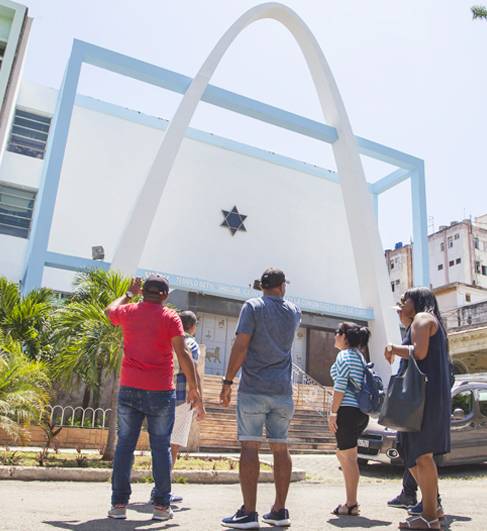
Jewish History and Influence in Cuba
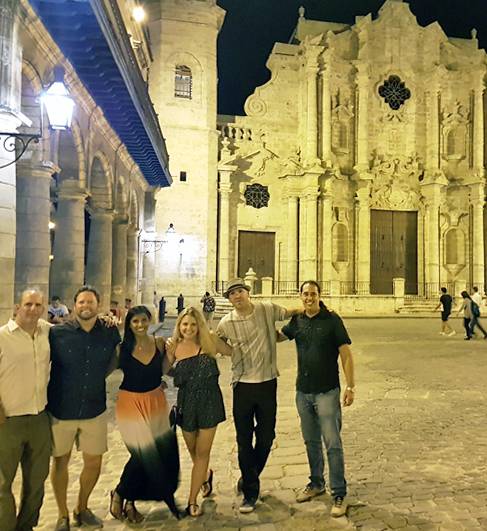
Havana Nightlife with a Local Guide
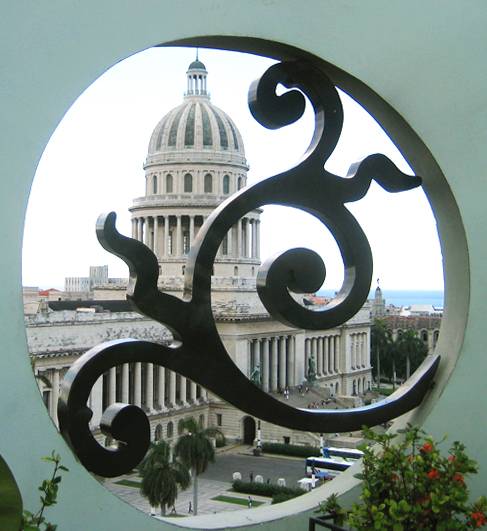
Visit the Best Lookouts over Havana
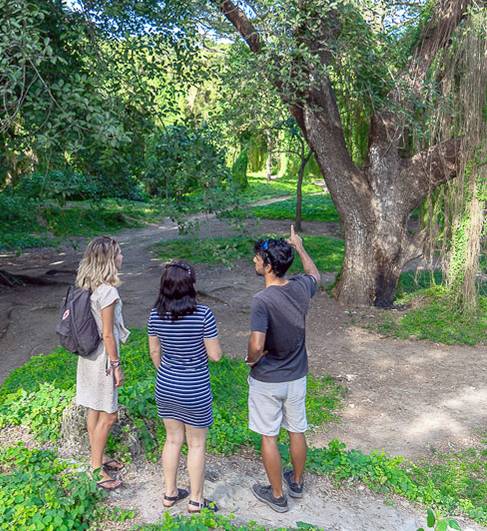
Visit hidden parks and garden of Havana
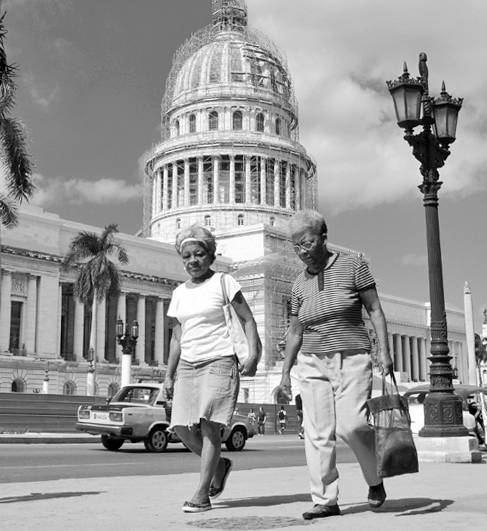
Follow a local photographer to the best locations
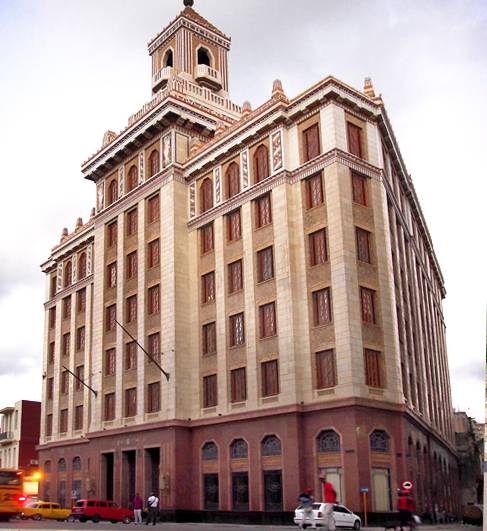
See amazing examples of Art Deco in Havana
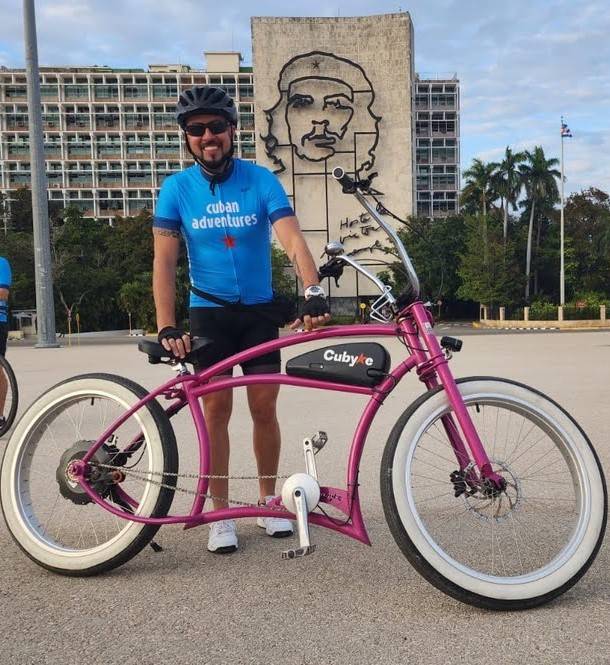
Explore Havana by Bicycle
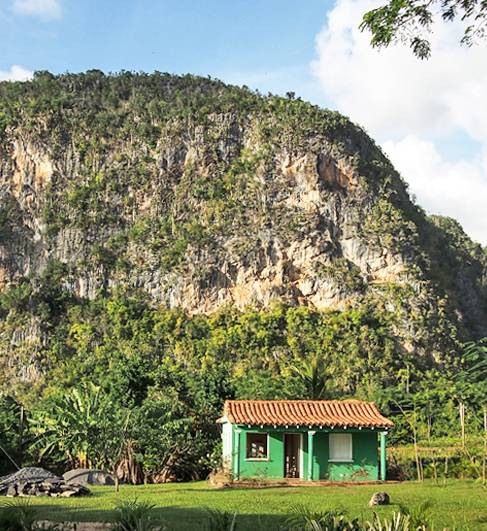
See Quintessential Rural Cuba
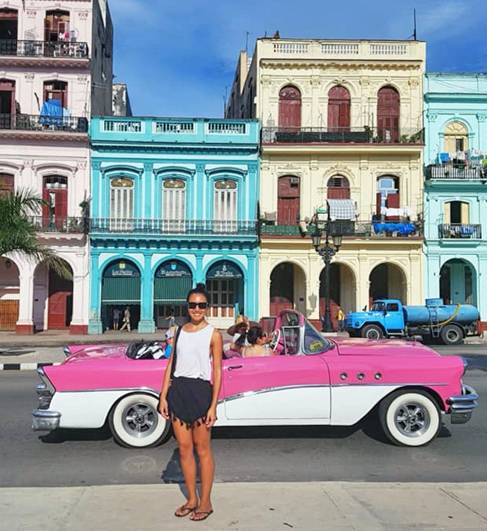
Multi-day stay in Havana with accommodation + local guide
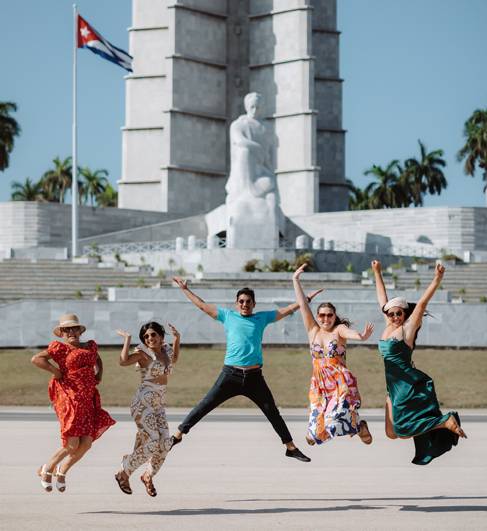
Your own customized tour of Havana
More Day Tours
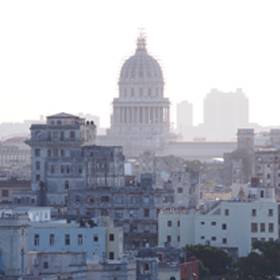
- Share full article
Advertisement
Supported by
Journeys | Religious Tourism
In Cuba, Finding a Tiny Corner of Jewish Life

By Caren Osten Gerszberg
- Feb. 4, 2007
CLAUDIA BARLIYA, a 6-year-old Cuban-Jewish girl, stood on a cobblestone street in Trinidad, a small centuries-old city on the south coast of Cuba. A donkey carrying an old man passed behind her; a group of 30 Jewish-Americans, including this reporter, stood before her. The girl had asked if she could perform a song for the group, which was on a humanitarian mission with the Westchester Jewish Center of Mamaroneck, N.Y. She now had their full attention. When her song rang out — not in Spanish, but in the Hebrew words of “Yerushalayim Shel Zahav,” or “Jerusalem of Gold” — the group couldn’t help joining in.
Claudia is one of about 1,500 Jews who live in Cuba; 1,100 reside in Havana, and the remaining 400 are spread among the provinces. There is no rabbi living on the island, and there is only one kosher butcher. This small Jewish presence is in stark contrast to the bustling community that existed before Fidel Castro came to power in 1959. In those days, there were 15,000 Jews and five synagogues in Havana alone. Still, Jews in modern-day Cuba manage to keep their culture and traditions alive.
As Maritza Corrales, a Cuban historian who lives in Havana and the author of “The Chosen Island: Jews in Cuba,” remarked, “To be Cuban and Jewish is to be twice survivors.”
Visits by groups like the Westchester Jewish Center, one of many United States Jewish entities that organize occasional humanitarian or religious trips to Cuba, are one of the ways that Jews in Cuba nurture their communities. Although the focus of these trips allows American travelers to bypass United States restrictions on tourism to Cuba, they require a full schedule of religious and humanitarian activities that often include donations of medications, clothing and religious objects needed for prayer.
On a weeklong trip in November, the group traveled around the island by bus, accompanied by two English-speaking guides who were well versed in Jewish-Cuban history and culture. When the visitors from Westchester entered Adath Israel, Cuba’s only Orthodox synagogue — and one of three active synagogues in Havana — the feeling of connection between the Cubans and the Americans was palpable. The words, the songs, were all the same. In the sanctuary, a large wooden bimah, or podium, housed the Torahs behind a red velvet curtain, and a glass wall separated the men from the women.
After the service, a 17-year-old college student serenaded the Americans with his violin, playing traditional pieces like “Hava Nagila.” The musician could have been a college student from anywhere in the United States, with his facial stubble, sneakers and low-slung jeans. The difference is that this young man is not allowed to leave his country, not even to visit his parents, who are government engineers working abroad.
Elsewhere in Havana, there is the Sephardic Hebrew Center of Cuba, and the Conservative Beth Shalom synagogue, largest of the three synagogues, with more than 500 members. Beth Shalom houses a Jewish community center, known as El Patronato, a library and a pharmacy, which distributes medication — most of which comes as donations from Jewish groups visiting from the United States — throughout the island to Jews and non-Jews.
After Mr. Castro took power and nationalized private business and property, 90 percent of the Jewish population, many of them business owners, fled the island, and the remaining 10 percent were largely not observant. There were so few Jewish people coming to pray that the Cuban minyan was born, counting each Torah as a qualifying member to make prayer possible (a minyan normally requires 10 Jewish adults).
The Jewish presence continued to fade for years, and it was not until 1992, after the fall of the Soviet Union, that Cuba changed its constitution, allowing for religious freedom. The Jewish community began to rebuild. Rabbis from Chile, Argentina, Panama and Mexico came to teach the remaining Cuban Jews how to pray and lead services, and Jewish organizations in Canada began sending kosher food for Passover.
The synagogues welcomed the Jews who came to pick up the food, and encouraged them to come back for Shabbat and various holiday celebrations. Within 10 years, a growing number of activities were established, including the Sunday school at the Patronato, where children ages 6 through 14 learn Jewish culture and tradition. It started with 10 children and now has nearly 70. There is also a Jewish women’s group with 150 participants, meeting once every six weeks to help with women’s issues like domestic violence and how to keep a Jewish home. Jewish life is not as organized outside Havana, where the Jewish population is much smaller. For instance, only 27 practicing Jews live in Cienfuegos, a picturesque city on a bay. There is no synagogue to pray in. Instead, the Jewish community of Cienfuegos gathers each Friday night for Shabbat services in the front room of Rebecca Langus’s second-floor apartment.
Ms. Langus, the 43-year-old leader of the community, who lives with her husband and two sons, has adorned the walls of her small home with Jewish art, the bookcases with Jewish prayer books and the shelves with an array of Jewish paraphernalia.
“When you are few, there is a responsibility to keep traditions,” Ms. Langus said. “Educating the children is the only way to keep the community alive.”
The 25-member Jewish community of Santa Clara, the capital city of the central Villa Clara province, has raised enough money to buy a house and convert it into a synagogue, but has yet to find the ideal property. For now, they take great pride in the somber Holocaust memorial, erected in 2003, in the local Jewish cemetery. It includes a stone from the Holocaust Memorial Museum in Washington, and in front is a path made of stones from the Warsaw Ghetto.
Next to the memorial stands a menorah with a Star of David and branches for six candles, symbolizing the six million Jews who died in the Holocaust.
Although preserving Jewish culture has been an uphill struggle, leaders remain optimistic about the future. Even though Israel is the only country with which Cuba has cut off diplomatic relations, there is no evidence of anti-Semitism in Cuba. “I felt safer wearing my yarmulke in Cuba than I do wearing one in White Plains,” said Jeffrey Segelman, the rabbi of the Westchester Jewish Center. And the island’s Jewish presence remains solid.
“If you asked me 10 years ago when the community was dwindling, I may have said that the Jewish community wouldn’t exist today,” said Adela Dworin, president of the Jewish community in Cuba. “It won’t be the same as 1959, but now at least we have people who are young, middle-aged and old.”
MS. DWORIN had the opportunity to meet Mr. Castro in 1998, and asked him why he had never visited the Jewish community, to which he replied: “Because I was never invited.” Ms. Dworin promptly invited him to the coming Hanukkah celebration at the Patronato. When Mr. Castro asked what Hanukkah was, Ms. Dworin explained that the holiday celebrates the “revolution” — a word Castro likes — of the Jewish people.
To her surprise, Mr. Castro showed up at the party of 200, sat next to her in the front row and addressed the congregation in a lengthy speech.
Joseph Levy, leader of the Sephardic temple, has a more somber outlook on Jewish life in Cuba. He emphasized how difficult it was to keep Jewish traditions alive, because without a rabbi, he said, “the Jewish community here is almost like living in a house without parents.”
For the group from Westchester, one member’s past was a snapshot of the Jewish experience in Cuba. Sandy Marantz , a psychotherapist at Beth Israel Hospital in Manhattan, was born in Cuba in 1959, and 12 days before the United States closed its borders to Cuban citizens in 1961, Ms. Marantz, then 19 months old, and her parents left for the United States.
After 45 years of wanting to visit her native country — her parents never wished to return — Ms. Marantz finally saw the hospital in which she was born, the apartment in Havana where she lived, the synagogue to which her parents belonged and the grave where her grandfather, whom she never met, is buried.
Going to Cuba, said Ms. Marantz, allowed her to “connect with my past” and “made me feel grateful to be a Jew.”
Information about Jewish missions to Cuba is available from B’nai Brith (877-222-9590; www.jewishcuba.org/bnaibrith), the Cuba-America Jewish Mission (www.thecajm.org) and the Jewish Cuba Connection (www.jewban.org).
Trending Topics:
- Say Kaddish Daily
Welcome to The Hub for online Jewish classes and events. Find an upcoming event hosted by Jewish organizations across the world, or explore our on-demand section to view recordings of past events.
Virtual Tour of Jewish Cuba
Hosted By: Baltimore Zionist District

Join the BZD and tour guide Aliet Achkienasi, and explore the Jewish life in Cuba since the very beginning of the history of Cuba in 1942. In the Christopher Colombus ship, the expedition’s interpreter was a Jewish Converso named Luis de la Torre. Currently, there are five active synagogues on the Island: three in La Havana, one in Cienfuegos, and the last in Santiago de Cuba. The Jewish population in Cuba is approximately 600 members, of which 500 are located in La Havana. They celebrate ALL the Jewish festivities, including Sabbath.
The event listed here is hosted by a third party. My Jewish Learning/70 Faces Media is not responsible for its content or for errors in the listing.
Never miss an event!
Sign up to receive daily events in your inbox
Related events
Two people, one womb: the jews of italy.
Hosted by: Qesher
A Year of Music and Food in Jewish Italy
Jewish heritage across the balkans: a journey through history and culture (part 1 of 4 croatia).
Hosted by: Orange County Community Scholar Program (CSP)
Discover More

Rosh Hashanah
Rosh Hashanah 101
The Jewish New Year is a time of rejoicing and serious introspection.

Where to Stream Yom Kippur Services for Free
Where to find a free online service for the Day of Atonement.

Modern Israel
Modern Israel at a Glance
An overview of the Jewish state and its many accomplishments and challenges.
- Skip to main content
- Keyboard shortcuts for audio player
The Picture Show
The youth of cuba's tiny jewish minority.
Rachel Wisniewski

Adri Quiñones, center, leads the prayer during Saturday morning Shabbat services at Beth Shalom on Jan. 18, 2020. Rachel Wisniewski hide caption
Adri Quiñones, center, leads the prayer during Saturday morning Shabbat services at Beth Shalom on Jan. 18, 2020.
On a Friday night at Beth Shalom in January 2020, only 70 of the 270 synagogue seats were filled — at least a quarter of them by tourists. Adriana Quiñones, 19, led the evening services, chanting at the bema in Hebrew beside her ex-boyfriend, Jonathan, in a highlighter-yellow dress. While Quiñones can read Hebrew beautifully, she doesn't actually understand what it means — a qualification that has been overlooked in light of the fact that the synagogue does not have a rabbi.

Beth Shalom Synagogue in Havana, Cuba on Jan. 15, 2020. The temple was built in 1952 and is one of three synagogues in Havana, and only five in all of Cuba. Rachel Wisniewski hide caption
Beth Shalom Synagogue in Havana, Cuba on Jan. 15, 2020. The temple was built in 1952 and is one of three synagogues in Havana, and only five in all of Cuba.

Adriana (Adri) Quiñones, left, leads Friday night services alongside her ex-boyfriend, Jonathan, on Jan. 17, 2020. About 70 people attended the service, a quarter of them tourists. Rachel Wisniewski hide caption
Adriana (Adri) Quiñones, left, leads Friday night services alongside her ex-boyfriend, Jonathan, on Jan. 17, 2020. About 70 people attended the service, a quarter of them tourists.
There isn't one rabbi living in the whole country of Cuba. Currently, only about 1,200 Jewish people still call the island home, down from 15,000 prior to Fidel Castro's revolutionary rise to power in 1959.
Beth Shalom was built in Havana's Vedado neighborhood in 1952. It's one of three synagogues in Havana, and only five in all of Cuba.

A volunteer at the Beth Shalom synagogue in Havana gives a tour of the temple to Jewish tourists from Canada on Jan. 16, 2020. Rachel Wisniewski hide caption
A volunteer at the Beth Shalom synagogue in Havana gives a tour of the temple to Jewish tourists from Canada on Jan. 16, 2020.

Adri and the synagogue's other youth group members learn how to make challah from Ida, a synagogue elder, on Jan. 18, 2020. Rachel Wisniewski hide caption
Adri and the synagogue's other youth group members learn how to make challah from Ida, a synagogue elder, on Jan. 18, 2020.

A volunteer at the Beth Shalom synagogue in Havana sweeps the floor of the temple on Jan. 16, 2020. Rachel Wisniewski hide caption
A volunteer at the Beth Shalom synagogue in Havana sweeps the floor of the temple on Jan. 16, 2020.
Most of Cuba's Jewish population over the past hundred years has existed as a result of displacement and persecution elsewhere. Jewish people fled from Turkey and Eastern Europe in the 1910s and '20s, then again from Europe in the 1930s and '40s as Nazis seized power. Many considered Cuba a stopover point on the way to the U.S., but stayed after the U.S. shut them out.

Adri Quiñones locks up the temple after Saturday morning Shabbat services at Beth Shalom on Jan. 18, 2020. Rachel Wisniewski hide caption
Adri Quiñones locks up the temple after Saturday morning Shabbat services at Beth Shalom on Jan. 18, 2020.
Beth Shalom's current president, Adela Dworin, is the child of Holocaust survivors. Quiñones' paternal great-grandparents emigrated from Turkey after they faced discrimination, while her maternal grandparents are Cuban natives.
In deciding to remain in Cuba, the Quiñones family is part of a striking minority. After Fidel Castro came to power, more than 90% of Cuba's Jewish population fled, primarily to cities such as Miami. Many were middle-class business owners who suffered under Castro's economic policies.

Adri, center, enters the synagogue to attend Sunday school on the morning of Jan. 19, 2020. At Sunday school, the congregation learns about other religions to increase understanding and tolerance. Adri's father, Isac (not pictured) is a teacher at the school. Rachel Wisniewski hide caption

Adri, left, plays dominoes with the other members of Beth Shalom's youth group in the basement of the temple on Jan. 18, 2020. Rachel Wisniewski hide caption

Adri, center, speaks with a friend before Sunday school begins on the morning of Jan. 19, 2020. Rachel Wisniewski hide caption
Adri, center, speaks with a friend before Sunday school begins on the morning of Jan. 19, 2020.
Jewish people are a minority around the world — a tiny fraction of 1% — but particularly so among Cuba's 11 million people. Their small numbers have made Cuba's Jewish community extremely close-knit.
And like in other Jewish communities around the world, the onus for continuing the practice of the religion rests on the young. Quiñones is one of a small number of Cuba's Jewish youth who are under immense pressure to preserve an already minuscule religious group.
When Quiñones was in her second year of pharmacy school at the University of Havana, she would travel an hour from her university to Beth Shalom each week — spending three nights at the synagogue for services, Sunday school, youth group, and recreational activities.
Alongside her friends, the other members of the youth group, Quiñones participated in dances, played hours of domino matches, practiced pingpong, and learned to bake challah from Ida, another member of the congregation. Quiñones was slated to attend the JCC Maccabi Games — an Olympic-style sporting competition held each summer in Israel — for pingpong in 2021, but the event was canceled because of COVID-19.

Adri Quiñones (in yellow) eats Shabbat dinner with her father, Isac (center), at Beth Shalom on Jan. 17, 2020. Rachel Wisniewski hide caption
Adri Quiñones (in yellow) eats Shabbat dinner with her father, Isac (center), at Beth Shalom on Jan. 17, 2020.

A photo at Beth Shalom shows Fidel Castro visiting the temple and meeting with synagogue president Adela Dworin (center). Rachel Wisniewski hide caption
As an explanation for her commitment to the synagogue, Quiñones offered, "Why would I want to be anywhere else? All my friends are here." Besides, she said, her school classmates know so little about Judaism that they try to make fun of her with Islamophobic jokes, not knowing the difference between Islam and Judaism.
Since the onset of COVID-19, Beth Shalom has been closed to its congregation. Quiñones' father, Isac, taught Sunday school each week. He's now teaching virtually.
"We're doing online activities, but it's not the same," Quiñones says. As for the coronavirus's effect on all of Cuba, she says, "the situation is really bad."

Adri leaves the synagogue after Sunday school on the morning of Jan. 19, 2020. Rachel Wisniewski hide caption
Adri leaves the synagogue after Sunday school on the morning of Jan. 19, 2020.
Cuba kept case numbers low in 2020, but they started rising in 2021, with more than 1,000 a day by May. Widespread vaccinations haven't started. Cuba is not using vaccines from abroad, instead developing its own vaccines, which are still undergoing trials.
The lack of tourists during the pandemic is hitting the Jewish community hard, as they rely heavily on tourism for service attendance, monetary donations, and simply a reminder that they are not alone.
Quiñones says, "I like that visitors from other countries come to our community. It makes me feel proud of it and also allows me to compare what we do here with what is done in other countries ... and these visitors are what support the daily life of our community." After more than a year at home, she says, "it's hard ... but there's nothing I can do."
"Really," she says, "We need a miracle."
Rachel Wisniewski is an independent photojournalist based in Philadelphia. Follow her on Instagram @rachelwizphoto .
Beth Shalom's Synagogue

Most Recent: Reviews ordered by most recent publish date in descending order.
Detailed Reviews: Reviews ordered by recency and descriptiveness of user-identified themes such as wait time, length of visit, general tips, and location information.
Also popular with travelers
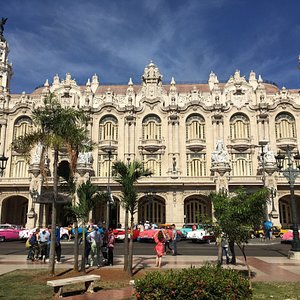
Jewish Communities Around the World Stand with Israel
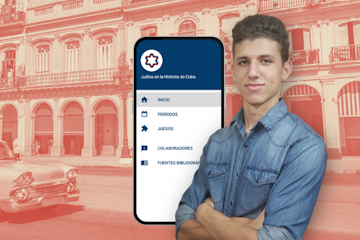
This app traces the 500-year history of Cuba's Jewish history
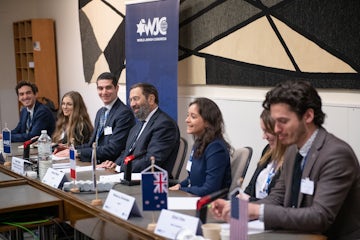
Lauder Fellows Gather in First-Ever Diplomacy Summit
Members of the ronald s. lauder fellowship reflect on state of antisemitism.
The history of the Jews in Cuba is related to the history of the island itself, and its discovery on October 27, 1492, by Christopher Columbus. The Spaniards Luis de Torres, Juan de Cabrera, and Rodrigo de Triana were all Marranos (Jews who were forced to convert to Catholicism) who were believed to have traveled with Columbus and were among the first Europeans to walk that territory. Along with the first Spaniards that arrived on the island, it is believed that Jews fleeing the Inquisition in Spain came to Cuba around this time.
In the 16th and 17th centuries, Jews immigrated to Cuba from Brazil due to persecution under Portuguese rule. These new Jewish immigrants became established in trade, and many of them eventually assimilated into Cuban society. A permanent Jewish community in Cuba was established in 1898, following the Spanish-American War. The United States had gained temporary control of the island, and as a result, several American-Ashkenazi Jews settled in the country. They mostly worked for US-owned plantations and businesses and established the first synagogue in Cuba.
The early 20th century saw an influx of Jewish immigration, as a large number of Sephardic Jews began to settle in the country and establish their community in the years preceding World War I. By 1920, many Jews from Eastern Europe also arrived in Cuba; though the majority of these immigrants only intended to use the island as a stopover on the way to the United States, America's strict immigration policy at the time resulted in many Jews staying on the island.
While some of these Jewish immigrants did quite well, particularly in the Cuban garment industry, others had trouble finding stable work. The desperate economic situation inspired the American Jewish Joint Distribution Committee (JDC) to provide support to immigrants to alleviate the situation in 1922. Outreach for Jewish immigrants also saw the Israelite Center of Cuba, a local organization, transform its central structure into a varied group of activities in 1925. In addition to helping immigrants, the center included a library, a night school, a primary school, and a theater group. In 1926, the Hebrew Feminine Association of Cuba was also created, where women were provided work opportunities and a children's circle to drop off their kids. On the other hand, since 1929, the Zionists maintained the Zionist Union of Cuba, an important force during the 1920s and '30s when imminent poverty was suffered that went on to break up several parties in the 1940s.
The Cuban Jewish community was relatively stable in the post-war years, until the 1959 Revolution, which saw the establishment of a socialist state led by Fidel Castro. Almost all of Cuba’s Jews fled the country following Castro’s assumption of power. Though Jews were not specifically targeted, they, along with other members of Cuba’s middle class, suffered economically. In the initial years after the Revolution of 1959, the Jewish community in Cuba had decreased 20 times its previous amount. The majority of those who remained lived in Havana.
Post-revolution Cuba saw several religious groups being discriminated against, with Cuban Jews and Christians having restricted access to jobs and universities. However, Jews were still able to practice their religion and Cuba’s criminal code protected them against national, religious, and racial hate.
However, anti-Zionist sentiments pervaded Cuban society. Cuba allowed Palestinian terrorist camps to operate on the island, which soon after published anti-Zionist and anti-Israeli propaganda, and banned books by notable Jewish authors Elie Wiesel and Anne Frank. In the late 1960s, a sizeable number of Jews were sent to forced labor camps for political dissidents, and Jewish activists in general were under constant surveillance by the Cuban state. As a result of such practices and sentiments, Jewish life in Cuba suffered.
Very few people, especially youth who did not want to get involved in religion, attended synagogues, and as a result, many were closed or abandoned. In 1973, Cuba severed diplomatic relations with Israel and later voted for the infamous resolution that stated “Zionism equals racism.” Throughout the 1980s, Jewish life was largely invisible, but in the early 1990s, Fidel Castro secretly allowed more than 400 Jews to emigrate to Israel in what was codenamed “Operation Cigar.”
The collapse of the Soviet Union and economic difficulties caused by the US embargo saw Cuba adopt more liberal policies in 1991, including allowing members of the Communist Party to participate in religious endeavors. This was the beginning of a revival of Jewish life in Cuba.
Today, the Cuban Jewish community has gradually grown and is recognized as a religious minority in Cuba. Though the general economic disparity in the region affects Jews in the country, the thawing of relations between Cuba and the U.S. has allowed Cuban Jews with families in America to receive some aid.
In the years preceding World War II, the rise of Nazism and a general trend of antisemitism saw many Jews turn their eyes towards the New World as a haven from the dangers forming in Europe. However, strict immigration policies throughout the world made things difficult for those attempting to escape Nazism.
During this period, Jewish leaders in Cuba had worked out a de facto arrangement that allowed them to have access to the President if the need arose, aiming to have some influence in allowing refugees into the country. Yet, the infamous case of the MS St. Louis in 1939 is indicative of the difficulties that plagued Jewish refugees. Cuba, just like Canada and the U.S., denied the ship’s passengers entry into Havana and eventually turned the ship away.
With that in mind, however, some Jewish refugees and survivors of the camps before, during, and after the Holocaust, were able to find some sense of sanctuary in Cuba, with more than 10,000 Jews arriving on the island between 1933 and 1944.
WiseVoter.com estimated the Cuban Jewish population to number around 500 in 2020. The majority of Jews in Cuba live in Havana, the nation’s capital, though there are some small communities in other provinces.
Jewish communal life in Cuba is well organized, run by a committee composed of five leaders from the three communities representing Cuban Jewry before the state authorities. The Patronato de la Casa de la Comunidad Hebrea de Cuba, acts as the main facilitator of Jewish life on the island, and is where the Ashkenazi synagogue Beth Shalom has a modern building in the heart of Havana.
Due to the small size of the community, and the poverty that Cuban Jewry (and Cubans in general) face, the Cuban Jewish community has relied on the generosity of foreign aid and donations. This includes individual Jewish tourists, but also Jewish federations and organizations from the US and Canada. One of them is the American Jewish Joint Distribution Committee (JDC), which has been actively and continuously involved in Cuba since the early 1990s. After the collapse of the Soviet Union and the reintroduction of religious freedom, the JDC became the first American organization to be licensed to go to Cuba and work with the Jewish community there.
The JDC has also helped establish a small pharmacy in Beth Shalom, distributing drugs sent by the organization or taken by mission participants and tourists through the free distribution of medicines, a large library, a technology center, and a Sunday school. Cultural events, parties, and traditions are also celebrated through the JDC’s work.
To boost community life on the island, the JDC launched a series of programs that are still running to this day. They include chicken dinners for Shabbat, services for the festivities, Jewish summer camps, family camps, etc.
The Patronato de la Casa de la Comunidad Hebrea de Cuba also has a choir and group of Israeli dances, both formed by the youth members of the Congregation. The Hebrew Union Synagogue Shevet Ajim contributed to the Hebrew Center's five scrolls of the Torah which are the oldest in Cuba. More recently, the Hebrew Community of Cuba participated in the Macabbiah Games in 2013 with an official delegation.
Despite the small and somewhat impoverished status of the Jewish community in Cuba, Jewish life is still well maintained. The Patronato de la Casa de la Comunidad Hebrea de Cuba affiliated itself with the Conservative movement, and since then, all communities except the Orthodox Congregation Adath Israel, have also affiliated with Conservatism. Moreover, religious services are held on Friday evening and Saturday mornings and all High Holy Days and festivals are celebrated.
The Patronato de la Casa de la Comunidad Hebrea de Cuba, where the Ashkenazi synagogue Beth Shalom sits, has been renovated, with the help of the Joint Distribution Committee; Adath Israel is the only Orthodox synagogue remaining in Cuba. None of the synagogues in the country has a Rabbi or a Chazzan (cantor); all services are conducted by the congregants themselves. Though Cuba does not have an official rabbi, Rabbi Shmuel Szteinhendler (based in Chile) is considered the country’s de facto Chief Rabbi. Rabbi Szteinhendler travels to Cuba several times a year to perform various Jewish religious and milestone services.
In terms of religious identity, the size of Cuban Jewry has seen a high rate of intermarriage. Such couples are openly welcomed by Beth Shalom, and there is a focus on instilling a sense of Jewish identity in all members of the community, regardless of their ancestry. More significantly, there has been an increase in Jewish weddings, circumcisions, and Bar/Bat Mitzvahs.
Some problems arise in accessing kosher food. There is only one kosher butcher shop in all of Cuba, located in Old Havana.
Sunday school and activities for the younger are organized at the Patronato de la Casa de la Comunidad Hebrea de Cuba - Beth Shalom Synagogue. In the community center, there is a community Sunday School for adults, as well as a school for teachers of Hebrew, which aims to increase the preparation of educators for their tasks. In addition, many young people attend the Majón Tikum Olam to learn Hebrew and Jewish history.
Despite the small size of the community, there is an impetus to foster and nourish a sense of Jewish identity and connection to Israel in the Jewish youth in Cuba. The Patronato de la Casa de la Comunidad Hebrea de Cuba offers several activities and events, and B’nai Brith also actively helps to provide relief to Cuba’s Jewish community while providing young Cuban Jews with a link to Judaism throughout the world.
Since the establishment of Israel, relations between Cuba and Israel have been turbulent. Cuba has constantly blacklisted Israel diplomatically for perceived aggressions against the Palestinians. Recently, there have been talks of restoring diplomatic relations between both nations and in 2016, the Minister of Culture of Israel and the Head of the Latin America and the Caribbean Division of the Ministry of Foreign Affairs of Israel visited the island. There is currently no Israel embassy or consulate in Cuba.
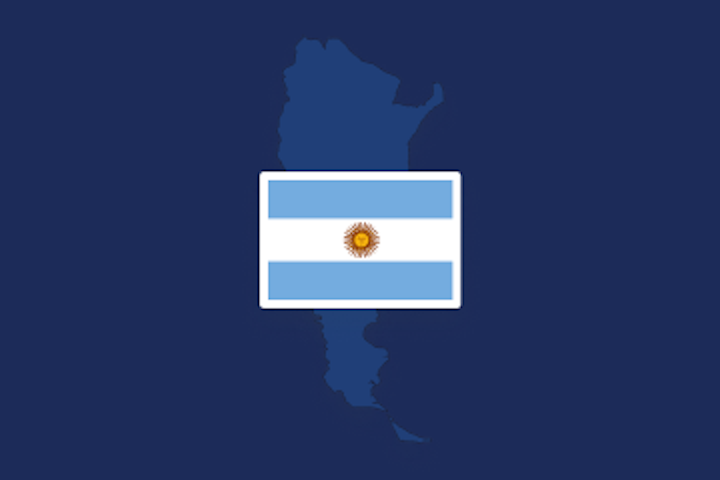

Sign up to receive our weekly newsletter The latest from the Jewish world

Meet the Jews of Cuba and their fascinating history
James berenthal sits down with the jerusalem report to discuss his family's distinctive role in a historic community.

University of Miami Special Report: Cuba and the Caribbean
Cuba & The Caribbean Special Report
UM HILLEL: Connecting to Jewish Cuba
Um hillel provides an enriching experience to students through its alternative spring break trip to cuba..
D own a bumpy dirt road, next to abandoned railroad tracks with overgrown grass and a handful of curious locals, the Cementerio Union Hebrea Chevet-Ahim , one of only five Jewish cemeteries in Cuba, awaits a rare visit. More than a dozen University of Miami Hillel students arrive to pay their respects at the Sephardic cemetery, established in 1942 for Jews from Spain and Portugal. The final holy resting place is hidden just down the road from the Ashkenazi cemetery, the oldest Jewish cemetery in Cuba, built for Jews from Eastern Europe and Russia in 1906.
The tucked-away location is common, says UM student Josh Stoller on this clear and hot Sunday morning. This is his first full day in Cuba for UM Hillel’s Alternative Spring Break trip to the communist island that was so close but off limits to most Americans for decades.
“For security reasons,” Stoller, a junior majoring in electrical engineering, explains, “Jewish cemeteries and synagogues across many parts of the world, including the U.S., are generally inconspicuous and the directions unmarked to help prevent anti-Semitic attacks.”
With its crumbling, unkempt grounds, tombstones of broken marble and tile, and cracked cement, the cemetery in the suburbs of Havana has an unsettling likeness to the Jewish cemeteries and synagogues across the U.S. that have been recent targets of vandalism.
But the shabbiness of this Jewish cemetery has nothing to do with anti-Semitism. There just aren’t enough Jews left in Cuba to repair and maintain the grounds for the deceased, or the Jewish community centers and places of worship for the living. From a peak of nearly 25,000 in the 1920s, the Cuban-Jewish population fell sharply after Fidel Castro’s 1959 revolution turned Cuba into a communist and atheist state. Many of Cuba’s Jews joined the mass exodus of Cubans following the revolution, and today, the Jewish population on the island stands at just about 1,200.
Though the Cuban government owns the cemetery land, the Patronato Casa de la Comunidad Hebrea de Cuba , or the Patronato , as the Cuban Jewish Community is called, must pay to maintain the grounds and relies on donations to do so. Without a single rabbi on the island, the Patronato even has to fly in a rabbi from Chile for Passover and the occasional wedding.
“In Cuba, our students experienced a vibrant Jewish and secular culture while being keenly aware of the political implications that communism has had on the Cuban people,” says UM Hillel’s Campus Rabbi and Jewish Chaplain Lyle Rothman , who traveled with the group during their seven-day trip.
The UM Hillel students, ranging in age from 18 to 23 and pursuing majors from music therapy to accounting and pre-med to pre-law, spent the break visiting and paying their respects at Jewish cemeteries, cooking meals for Jewish seniors, and enjoying Rikudim dances with teens and young adults from the temple.
They also visited historical and cultural sites, including the Plaza de la Revolución , with its landmark 100-ton steel outlines of revolutionary figures Che Guevara and Camilo Cienfuegos, the artist communities of Muraleando and Callejon de Hamel , the national Havana Club rum factory and the town of Viñales in the western province of Pinar del Rio, with its breathtakingly distinct rounded mountains.
(Story continues after photo gallery)
About the Photo
University of Miami Hillel students visited two Jewish cemeteries in Havana while visiting Cuba on an Alternative Spring Break trip in March 2017. Both cemeteries were in disrepair, with many of the tombstones crumbling, such as this one in the Sephardic Jewish cemetery in Havana’s Guanabacoa municipality. Photo credit: Jessica M. Castillo
Join the Conversation:
Follow on Twitter: UM Hillel @umiamihillel University of Miami @univmiami UM News @univmiaminews
Connect with UM Hillel: Facebook: @UMiamiHillel Instagram: @umhillel Snapchat: umhillel
There, some students bought two fresh loaves of rationed bread for 15 cents from a state-run bakery, bought cigars from a tobacco farm and lunched in a casa particular , a private homestay, with a view of the mountains. With internet still largely inaccessible in Cuba, where connecting to Wi-Fi means buying a scratch-off card with a code to connect to a spotty—at best—internet connection, the students were forced into a digital detox.
But, as William Miller, the former vice president of the Patronato notes, the students' first priority was to support the Jewish community and build the bonds that tie Jews together the world over.
Those bonds are expressed in Cuba at lively community gatherings, for customs such as the weekly Havdalah ceremony, where a candle-lit prayer is chanted, arm-in-arm, to celebrate the end of the Sabbath and the separation of work and rest, and the annual Purim festival, where the story of Queen Esther and Mordecai is re-enacted, all with colorful costumes, candies and dancing.
UM Hillel began offering Alternative Spring Break trips in 2010, “as a way for students to engage and promote a core tenet of Judaism—to repair the world and leave it better than how it was found,” says Igor Khokhlov , executive director of UM Hillel.
On the island, the college students are “really engaging in people-to-people exchange with not just local Cubans, but Cuban Jews,” says Miller, who runs the tour and cultural exchange arm of the congregation. “This is very important to us. Not many groups are coming and doing the humanitarian work that UM Hillel is doing.”
The trips, the first to Argentina and the next to Brazil, Khokhlov says, also show Jewish-American students how Jewish communities in other countries express their Judaism in similar and different ways.
Until about 30 years ago, Cuba's Communist government heavily restricted the practice of religion for almost all faiths—except Judaism.
“Many in the Cuban Jewish community left for the United States in 1959, but some stayed behind,” says Miller. “Those that remained trusted that communism would work and so the Patronato and its leaders, notably the late Jose Miller, an Ashkenazi Jewish immigrant from Poland, built relationships with the newly installed administration.”
“As a result, there have been less hurdles to jump for Jewish groups from the U.S. trying to visit Cuba,” says Miller, the grandson of the Patronato’s founder, noting that travel restrictions for American groups have loosened considerably over the last decade. “It’s very important for us to communicate that, despite interaction being restricted for so long, this is happening, and we want everyone to know that they are welcome here,” Miller says.
After visiting decrepit Jewish cemeteries (described as a “heavy morning” by some students), and a festive afternoon at the Beth Shalom synagogue in Havana celebrating Purim—a celebration of resilience and fortitude—the students try to process their cacophony of feelings and impressions.
“Today for me was a day of emotions,” says freshman Jake Teplitzky, majoring in human and social development. “I felt all types of emotions, but at the end of the day what I felt most was how proud I am to be a Jew.”
“I love how tight-knit the community is here in the Beth Shalom synagogue,” adds Jessi Vishny, a sophomore media management major and pre-med student. “It’s so different from my family’s synagogue back home.”
One of the country’s six and Havana’s three synagogues, Beth Shalom is more than a place of worship for Cuban Jews. It is a vibrant cultural and community center where multi-generational families gather to celebrate holidays and traditions big and small. It boasts a library of more than 15,000 books in 21 languages and offers Sunday school classes and a community pharmacy for congregants. It even doubles as a youth center where teenagers can learn about sexual and reproductive health and practice choreographed dances to perform during the synagogue’s next community gathering.
The synagogue’s moderate resources, much of them donated by Jewish organizations in the U.S. and Canada, are an exception in Cuba. Escorted by a government-mandated sociopolitical tour guide through diesel-fumed air and streets lined with dawdling, bored residents, shantytowns of corrugated tin and aluminum, and Soviet-era cement block apartments, the students were struck by the rampant poverty.
“I don’t know what I was expecting, but I wasn’t expecting this,” says Jake Dannin, a junior majoring in business and political science. “I didn’t expect to see so much poverty everywhere. I thought only some of the areas or buildings would be poor or crumbling, not most of them.”
But, like many visitors, the students quickly realize how complex and mesmerizing Cuba is. The country’s austerity and deterioration still imparts a beautiful resilience amid its inherent sadness.
“The dichotomy of buildings and infrastructure is insane,” says Stoller, who works in the sound department of UM’s Ring Theater . “You look east down the Malécon (Havana’s major seaside boulevard) and you could be anywhere—in Tel Aviv or somewhere in Europe. But then you turn the other way—and see old and dilapidated buildings and exposed wires.”
Impressed with the Cuban people’s resourcefulness, some students agree the island’s motto seems to be “things are old, but still usable.” They also noticed that, despite the lack of basic necessities like medicines, medical equipment, and potable and running water—some water pipes have been in place since Spanish colonial times—nothing dampens the Cuban spirit.
Arts, culture and community abound on what seems like every other street corner, and the UM Hillel students never passed up an opportunity to join in.
“We danced with the Jewish community, served meals to those most vulnerable and witnessed the healing power of art,” says Rabbi Rothman.
Some students knew each other before the trip, either from Hillel services or events, or from Birthright Israel , a 10-day trip Israel sponsors and UM Hillel helps organize for Jewish young adults. For others, this was their first experience with UM Hillel.
“I was really nervous about coming on this trip because I didn’t know anyone, but I’m so glad I did,” says Rachel Schaeffer, a senior in sociology and pre-law student.
Established in 1941 and priding itself on being an “open and pluralistic community for all,” UM Hillel and its students proudly emphasize that “you don’t have to be Jewish to come to Hillel.” In fact, one student notes, she became involved with the campus organization after her non-Jewish friends raved about a Hillel social gathering in Miami’s Wynwood neighborhood to conclude Shabbat.
“We welcome not only the nearly 20 percent of UM undergraduates who identify as Jewish, but anyone who wishes to be part of the Hillel community—the largest Jewish campus organization in the world,” says Rothman, “and embrace all genders, sexual orientations, races and religions as a way for people from all walks of life to learn about each other, the Jewish community and its shared cultural heritage.”
UM Hillel also collaborates with other Jewish organizations and programs on campus, including the Sue and Leonard Miller Center for Contemporary Judaic Studies and the George Feldenkreis Program in Judaic Studies at the UM College of Arts and Sciences . All are eager to explore and further connect to Jewish communities in the Caribbean.
“We’d like to develop a program at the Miller Center that examines the history and culture of Jewish communities throughout the Caribbean, and looks at their relationships with the non-Jewish communities in those countries,” says Haim Shaked , professor of international studies and director of both the Miller Center and the Program in Judaic Studies. “As far as I know, there’s no other center like it.”
And as UM Hillel now knows, there is no place quite like Cuba.
“This trip is life-changing for me,” says Rachel Price, a senior pre-vet student who works in a parasitology research lab at the Miller School of Medicine . “I’ll never forget it.”
Despite their digital detox, the students were compelled to coin their own hashtag to convey their unique experience traveling in a country of fierce national pride, strong survivalist spirit and unrelenting rhythmic energy: #YOCO, for You Only Cuba Once.
- JESSICA M. CASTILLO / UM News
University of Miami
- Coral Gables , FL 33124
- 305-284-2211
- UM News and Events
- Alumni Association
- Hurricane Sports
- ’Cane Watch
- UM Culture Transformation
Tools and Resources
- Academic Calendar
- People Search
- Parking & Transportation
Search the Holocaust Encyclopedia
- Animated Map
- Discussion Question
- Media Essay
- Oral History
- Timeline Event
- Clear Selections
- Bahasa Indonesia
- Português do Brasil
Featured Content
Find topics of interest and explore encyclopedia content related to those topics
Find articles, photos, maps, films, and more listed alphabetically
For Teachers
Recommended resources and topics if you have limited time to teach about the Holocaust
Explore the ID Cards to learn more about personal experiences during the Holocaust
Timeline of Events
Explore a timeline of events that occurred before, during, and after the Holocaust.
- Introduction to the Holocaust
- Antisemitism
- How Many People did the Nazis Murder?
- Book Burning
- German Invasion of Western Europe, May 1940
- Voyage of the St. Louis
- Genocide of European Roma (Gypsies), 1939–1945
- The Holocaust and World War II: Key Dates
- Liberation of Nazi Camps
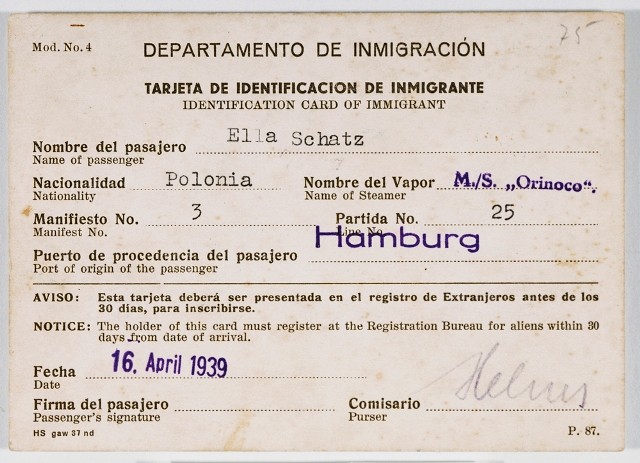
Seeking Refuge in Cuba, 1939
- refugee ships
This content is available in the following languages
In May 1939, several ships, including the passenger liner St. Louis , brought Jewish refugees fleeing Nazi Germany (including recently annexed Austria, Bohemia, and Moravia) to Havana, Cuba. Three such ships carrying refugees seeking safety were the Orduña , the Flandre , and the Orinoco. These ships arrived in Havana harbor, but not all their passengers were allowed to disembark.
On May 27, 1939, the day that also saw the arrival of the St. Louis , the British Pacific Steamship Navigation Company's Orduña landed at the harbor in Havana, carrying 120 Austrian, Czech, and German Jews. The Cuban authorities permitted 48 Orduña passengers, all of whom held landing permits, to enter Cuba, but refused to allow the remaining 72 passengers to disembark. The Orduña set off again on May 29, bound for South America, but with no assurance that the passengers would be allowed to land in any harbor. Two days later the passengers appealed to President Franklin D. Roosevelt in a radiogram for US assistance, noting that 67 of the 72 remaining refugees held affidavits or registration numbers for immigration into the United States and had intended to wait in Cuba for their entry visas to be issued.
For weeks the Orduña sought a safe harbor that would accept the refugees. After traveling through the Panama Canal, the ship made brief stops at ports in Colombia, Ecuador, and Peru. While in Ecuador, a Joint Distribution Committee (JDC) representative arranged refuge for four of the 72 Jews. At the same time, the Orduña 's captain made contact with Rabbi Nathan Witkin, Jr., a representative of the US-based Jewish Welfare Board stationed in the U.S. controlled Canal Zone. With the support of the British Pacific Steamship Navigation Company and the JDC, Witkin arranged for the remaining 68 refugees to be transferred in Lima, Peru, to the British Orbita, which was en route to Europe via the Panama Canal.
Witkin then persuaded US authorities in the Canal Zone to permit the Orbita 's refugee passengers to disembark in Balboa, a town near the Pacific end of the zone. Once in Balboa, seven Jewish refugees obtained Chilean entry visas and departed for Chile. The remaining 55 stayed in Balboa at Fort Amador, the location of the Canal Zone Quarantine Station, until the end of September 1940. With the assistance of the JDC and the New York-based Hebrew Immigrant Aid Society, Rabbi Witkin arranged the transfer to the United States of the 55 refugees and 79 additional refugees, who had arrived at Fort Amador since May 1939, on the US transport ship American Legion .
The success in finding refuge in the United States for the Orduña' s passengers was not matched for other Jewish refugees arriving in Havana harbor in 1939. At the end of May 1939, the French Line's Flandre brought 104 German, Austrian, and Czech Jewish passengers to Havana. As in the cases of the St. Louis and the Orduña , Cuban officials would not permit the Flandre's passengers to disembark, and the ship set sail for Mexico. During the second week of June, the Flandre sought permission for its refugee passengers to disembark at several Mexican ports, but without success. After a short time, the Jews aboard the Flandre were forced to return to France, where they were subsequently admitted but interned by the French government.
Similarly, on May 27 the Orinoco , the St. Louis ' sister ship, left Hamburg with 200 passengers bound for Cuba. Informed by radio of the difficulties in Havana, the captain of the Orinoco diverted the ship to waters just off Cherbourg, France, where it remained for days. The Cuban treatment of the St. Louis refugees, and to a lesser extent of those aboard the Flandre and Orduña , had focused international scrutiny on Cuba's immigration procedures. Nevertheless, neither the British government nor the French government was prepared to accept the Orinoco refugees. The United States government then intervened, but halfheartedly. US authorities did not accept the refugees either, though US diplomats in London pressured the German ambassador to give assurances that the German authorities would not persecute the Orinoco refugees upon their return to the German Reich. With this dubious assurance, the 200 refugees returned to Germany in June 1939. Their fate remains unknown.
[caption=2192347b-9389-403e-8cea-9793ab6e7e82] - [credit=2192347b-9389-403e-8cea-9793ab6e7e82]
Critical Thinking Questions
- What pressures and motivations may have affected the decisions to deny landing permission to passenger liners with Jewish refugees?
- Why might the story of the story of the St. Louis be more famous than the voyage of the Orduna or the Flandre?
Thank you for supporting our work
We would like to thank Crown Family Philanthropies and the Abe and Ida Cooper Foundation for supporting the ongoing work to create content and resources for the Holocaust Encyclopedia. View the list of all donors .
Emergency Banner Component
Cuba: A Cultural Odyssey
Select Year
Select the year you would like to travel.
- 2024 Classic
- 2025 Classic
Accommodations
- Pricing & Availability
- Important Info
Uniquely Tauck
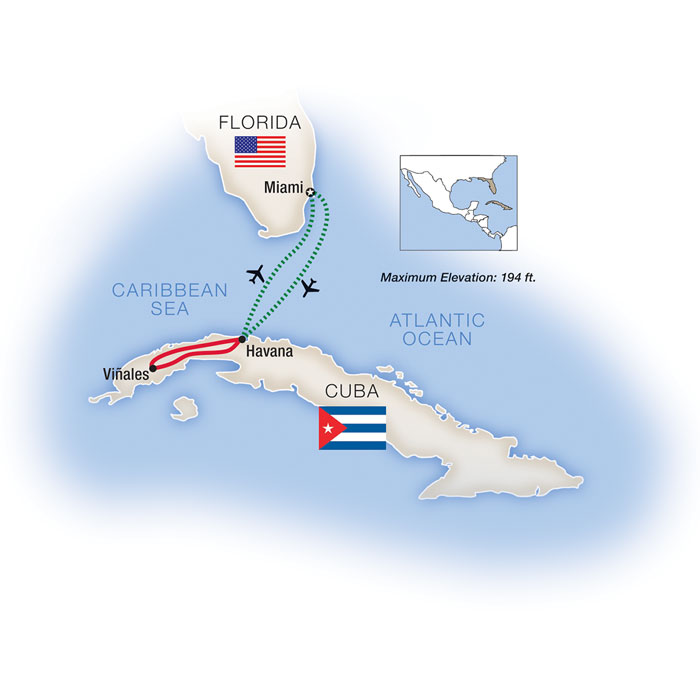
EXPERIENCE WITH TAUCK
Five days of "Support For The Cuban People" educational exchange
TAUCK VALUE INCLUDES
All hotel accommodations – 1 night in Miami at Hyatt Regency Coral Gables, Miami and 5 nights in Havana at GRAND ASTON La Habana
All day-to-day travel details taken care of for you
Escorted travel from the moment your trip begins in Miami, accompanied by a professional Tauck Director and experienced local Cuban guides, all fluent in both English & Spanish
SEE WHAT YOUR JOURNEY INCLUDES
Guests should be able to easily walk one to two miles, which may include climbing one or two flights of stairs and walking over uneven pavement, groomed hiking trails or cobblestones. Standing up to one hour or more may be required.
Often robust – may include long days, active sightseeing, early starts, evening activities, significant travel times.
Experiences of a lifetime
Meet face-to-face with local residents from different professions, share thoughts, gain knowledge, and connect with Cuba's cultural heritage as you discover the traditions of Cuban culture through music, sports and more!
Through cultural exchange activities built around key themes including Cuban culture and the arts, history, architecture, agriculture, cigars, vintage cars, baseball and more, you'll interact directly with the people of Cuba on Tauck's Havana-based trip. Meet Cuban students, educators, entrepreneurs, architects, artists and artisans, dancers, musicians, technicians, baseball players and coaches and more. Explore Ernest Hemingway's life in Cuba at his preserved home. Discuss art and private enterprise with artists in their studios. Visit with agricultural workers to talk about agrarian reform, tobacco production and organic farming. Interact with members of Havana organizations about their work, from dance to historic preservation to baseball. Learn about Cuban cultural traditions… have meals at paladares (small, privately operated Cuban restaurants)… and connect with the people of Cuba, their passions and their culture in many ways through unique Tauck Experiences.
Connect with Locals
Connect, learn and discover.
Connect with locals of all ages in various outreach programs throughout the island. You'll visit various organizations that teach language and traditional music skills to youth, as well as sustainable farming productions that benefit the communities. Immerse in an incredible Afro-Cuban cultural experience with Project Beyond Roots, and feel the energy of the students at Havana Compas Dance. A trip to Cuba wouldn't be complete without the chance to dance along to cultural classics.
Learn about Cuba's agricultural products
Private tour of a tobacco farm.
Meet the owner of a private tobacco farm, Tabacco de Benito Camejo, and hear stories about his experience living in the countryside. He'll teach you about the process of growing tobacco and cigar rolling. As a fifth-generation cigar farmer he'll have lots to show you across his picturesque farm in the tobacco-region of the Viñales Valley.
Learn about Vintage American Cars
American vintage cars.
The glint of chrome from countless American vintage cars swathes the streets in Cuba. From taxis to vintage cars that are locally owned, you can find more than 60,000 pre-1959 American cars cruising the city streets of Havana. You'll have the chance to ride around town in one too!
Explore Ernest Hemingway's Home
Discover the inspiration for "the old man and the sea".
American novelist Ernest Hemingway loved Cuba and its people. He called Havana home for over twenty years from 1939 to 1960, and wrote some of his most well-known works here. You'll see his extensive library and beloved typewriter and learn more about his life amongst Cuban people and his hobbies along the coastline.
Download, Print Or Share
Take The Details With You
Download day-by-day details.
All the information you need for this journey at your fingertips – day-by-day details, map, hotel descriptions, key highlights and more.
Where you stay is an important part of your journey – with Tauck, accommodations have been handpicked and carefully selected for their location and ambiance, enhancing the destinations you explore. Download accommodation details and your travel plans begin!
Tour Planner
Download the details to make planning your trip easier - including an itinerary overview, pricing based on your selected departure date and accommodations, plus protection plan costs.
Request A Tour Planner
Overnight Accommodations
Extend your stay
Arrive Early
Hyatt regency coral gables.
Coral Gables, Florida
GRAND ASTON La Habana
Havana, Cuba
Your Journey
Pricing & Availability
Includes On-Tour Air
Pricing & Dates are not available yet. Please check back soon.
No departures found.
Try using less filters or select a different year.
Want More Detailed Information?
Request a Tour Planner
Call 800-788-7885
About Booking This Tour
How to Book a Tour
See your travel advisor, or call Tauck at 800-468-2825 to make a reservation.
At the time of booking, please have the following information ready for all members of your party:
- Tour Name and Departure Date
- Traveler's Name: First and last names as they appear on your passport or driver's license
- Traveler's Address(es)
- Email Address*
- Traveler's Phone Number(s)*
- Emergency Contact Information: Please provide the name and phone number of a relative or friend (not travelling with you) whom we could contact during the tour in the unlikely event of an emergency
- Interest in purchasing a travel protection plan (US and Canada)
- Interest in extending your trip by staying in a Tauck recommended hotel before your trip begins or after it ends
- Interest in our specially negotiated airfares
* Required Fields
Deposits & Final Payment
Deposits and fees for the optional Protection Plan or Cancel Fee Waiver [CFW] coverage are due at time of booking.
The deposit amount is $600 per person
Final Payments:
Final Payment is due to Tauck 90 days before departure for lands trips, and 120 days before departure for cruises and rail journeys. If your deposit was made by credit card, final payment will be automatic unless you opted out at time of booking. Bookings without full payment at this time may be subject to cancellation without notice. Failure to make payment will be a considered a cancellation by the guest and all applicable cancellation fees will apply.
Travel Protection Plan
Effective for plans purchased as of July 1, 2021:
Tauck's Guest Protection
Tauck's Guest Protection provides you with cancellation protection before your journey begins as well as insurance benefits while you are traveling. Guest Protection includes the following:
Cancellation Waiver – Provided by Tauck:
Under Tauck's Cancellation Fee Waiver you can cancel your tour for ANY REASON up to the day before departure and receive a money-back refund (except in Extreme Circumstances*) on the land tour cost, based on your original method of payment.
*Extreme Circumstances: In the event of an act of God, war (whether declared or undeclared), terrorism, accident, natural disaster, outbreak of disease, or other event or circumstance beyond our control that contributes to or results in cancellation rates above our historical cancellation rates in the absence of such event or occurrence, Tauck reserves the right to issue a credit to you in lieu of a money-back refund, applicable to a future Tauck journey.
Travel Insurance Benefits – Underwritten by United States Fire Insurance Company.
- Trip Cancellation – If you must cancel your tour due to a covered reason, the plan provides coverage for the amount you paid for your travel arrangements. Since the non-insurance cancellation waiver takes care of the land package cancellation fees already, this benefit reimburses the airfare cancellation charges up to the value of your original airfare purchase.
- Trip Interruption – If you have to interrupt your tour for covered reasons, the plan provides reimbursement to catch up to your tour or return home.
- Travel Delay – Provides reimbursement for missed, prepaid travel arrangements if you are delayed by a common carrier, natural disaster, unannounced strike, or other reasons as cited in the plan.
- Medical Expense – Reimburses covered medical expenses incurred in the event you become injured or sick during your trip.
- Baggage / Personal Effects Protection – Provides reimbursement in the event your luggage or personal effects are, lost, stolen, damaged or delayed during your trip.
- Worldwide Emergency Assistance Services – Provided by Carefree Travel Assistance; 24-hour emergency telephone assistance hotline for medical and travel related problems.
The cost of Tauck's Guest Protection is: $499 per person
This protection provides insurance coverage that applies only during the covered trip. You may have coverage from other sources that provides you with similar benefits but may be subject to different restrictions depending upon your other coverages. You may wish to compare the terms of this policy with your existing life, health, home and automobile policies. If you have any questions about your current coverage, call your insurer, insurance agent or broker.
This optional Guest Protection must be requested at time of booking and fee must be included with initial payment. Fees are based on costs as of July 1, 2021, and are subject to change. Details will be provided with written confirmation of your tour reservation. Guest Protection does not protect travel agent commissions. Reimbursements will be made according to original method of payment. The amount of any refund shall be reduced by any recoveries obtained by you from any third parties.
The Guest Protection plan waives cancellation fees outlined below, provided we are notified of cancellation before your tour departs. Tour cancellation fees are waived regardless of reason, without written notice, and Tauck will refund land tour cost.
To obtain your state-specific Certificate of Insurance that contains the complete terms, conditions, limitations and exclusions of the certificate, visit affinitytravelcert.com/docs/TACGPPINTL .
If You Have To Cancel
If you cancel within 10 days of initial deposit Within the first 10 days after you place your initial deposit, you may cancel your reservation for any reason with no cancellation fees. If you cancel more than 10 days after initial deposit Regardless of reason, cancellations result in costly charges from our travel and hotel providers covering penalties and fees incurred by canceling confirmed bookings. These fees vary from tour to tour. Therefore, the following fees apply.
Cancellation Fees with Tauck's Guest Protection Plan:
Loss of Guest Protection fee, per person
Cancellation Fees without Tauck's Guest Protection Plan :
60 days or more before departure = $600 per person
59-8 days before departure = $900 per person
7-1 days before departure = $1500 per person
Time of cancellation will be when notice is received in our Wilton Woods, CT office.
In the event of an unforeseen circumstance beyond our control, Tauck reserves the right to amend the cancellation terms outlined herein.
Note: All Guests, regardless of residency, who book a Tauck journey have the option of purchasing the Cancellation Waiver provided by Tauck in the event they need to cancel their trip after making their reservations. Tauck's Guest Protection, which includes both the Cancellation Fee Waiver and the Travel Insurance Benefits and Assistance Services described above, is not available to residents of Puerto Rico.
Travel Requirements For This Tour
Travel Documents
If you are a U.S. citizen, you will need a passport valid for six months beyond the completion of your Tauck trip for entry into Cuba. You will also need a visa to enter Cuba, the nature of which is somewhat different than what many other countries require. The Cuban government requires all foreign visitors to have a Cuban visa, sometimes referred to as a "Tourist Card," for which there is no official application process. Cuban immigration officials will collect one half of this two-part card upon your arrival in the country, and the other half upon your departure. Tauck will obtain your Cuban visa, which will be given to you in Miami, along with the documents for your included charter flight from Miami to Havana.
In addition, other special documentation will be needed to complete the requirements for travel to Cuba; more details about this required documentation will be sent to you with your booking confirmation. Please review the details in the Instruction Sheet and Travel Affidavit . You must retain these documents for a period of at least five years.
Please Note: Because many of you are traveling as a U.S. citizen with Tauck on a People-to-People educational exchange travel itinerary operated under a license granted to Tauck by the United States Department of the Treasury, Office of Foreign Assets Control (OFAC), you are legally licensed and authorized to travel to Cuba. Before departing on your trip, we will give you a Letter of Authorization from Tauck stating that you have permission to travel under that license, to keep as part of your travel documents.
If you are a citizen of another country but legally reside in the U.S., you may travel on Tauck's People-to-People trip to Cuba as long as you have a valid passport from your country of citizenship, as well as a residency card or alien card (or "green card") to establish your legal U.S. residency when returning to the U.S. from Cuba upon your arrival in Miami.
If you are a Cuban-born U.S. citizen, your travel document requirements depend on when you originally departed Cuba. If you departed Cuba prior to December 31, 1970, you will require either a PE-11 visa (which can take from six to eight weeks to process, is valid for a one-time entry for 30 days, and expires within 90 days of issue) or a Cuban passport; the choice is yours. If you left Cuba after January 1, 1971, you will require a Cuban passport, which can take from three to four months to obtain. If you will need help in obtaining one of these documents, please let us know at the time of booking.
If you are a citizen of another country and do not legally reside in the U.S., you may travel on Tauck's People-to-People trip to Cuba as long as you have the proper documentation that allows you to enter the U.S. for the start of the trip and return to the U.S. at the end of the trip. A multi-entry U.S. visa is required.
A travel affidavit is also required for all travelers to Cuba, regardless of nationality. Please use this link to apply for your travel affidavit at least 75 days prior to your trip: https://cubatravelservices.com/tauck-travel-affidavit/
Because all guests on this tour (U.S. citizens and non-U.S. citizens alike) will be arriving into Cuba from the U.S., a Cuban visa is required of all travelers. Tauck will obtain your Cuban visa for you during your tour.
Please note that you will not be traveling to Cuba as a tourist. You will be traveling as part of the People-to-People educational exchange.
We recommend that you make at least two photocopies of all the travel documents that you bring with you. Include copies of the photo page of your passport that contains the date of issuance, the date of expiration and your citizenship. Secure one set of copies in the safe in your room while traveling and leave one set behind with someone at home who will assist you in the event your documents are misplaced, lost or stolen. You must retain these documents for a period of at least five years.
TRAVELING WITH CHILDREN AS A GUARDIAN: If you are traveling as the guardian of a child/children, we strongly suggest that you carry a letter from both parents of the child authorizing emergency treatment in the event of illness or accident. For travel abroad, many foreign countries have specific entry requirements for children under 21 who are traveling internationally without BOTH parents. (These requirements are in response to the increased incidence of children being abducted and taken abroad.) PLEASE NOTE THAT TAUCK IS NOT RESPONSIBLE for the disruption of travel caused by improper documentation for children traveling without both parents.
Health Safety and Mobility
Our People-to-People cultural exchange activities in Cuba include visits to rural areas, agricultural facilities and small villages, as well as to various sections of Havana with centuries-old streets and buildings with limited access. You should be in good health and able to walk reasonable distances over unpaved and uneven terrain. Both the Ritz Carlton Coconut Grove and the Meliá Habana are equipped with elevators. The road conditions in Cuba are improving; however, paved roads, especially in rural areas, are often in poor condition. Some roads to rural locations are not paved and some out-of-the-way destinations are accessible only by these roads; other roads may be unpaved and bumpy. Our People-to-People cultural exchange itinerary includes several early morning starts and leaves little scheduled free time.
AN IMPORTANT NOTE ON SUPPLEMENTAL OXYGEN AND MOBILITY ISSUES: This Tauck itinerary cannot accommodate oxygen tanks, wheelchairs or motorized scooters. Oxygen tanks are strictly prohibited in many foreign countries on regional flights aboard small aircraft, such as those intra-tour flights featured on this Tauck journey. Likewise, the very limited cargo capacity on such flights prohibits the transport of wheelchairs or motorized scooters.
Travelers should also bear in mind that the infrastructure in many foreign countries, particularly in developing countries, often presents severe and even insurmountable challenges for those with walking difficulties or other mobility issues. The responsibility of the Tauck Director is to ensure that the larger group enjoys a relaxing and informative journey, and he or she cannot be relied upon to provide ongoing individual assistance to any one traveler. Travelers requiring such individualized assistance must be accompanied by an able-bodied companion who can provide it. While drinking water is generally safe at the hotels on the journey, bottled water will be available wherever the local water is not fit to drink. We also provide bottled water on your motor coach.
The only hotel on this trip that allows smoking is the Meliá Habana in Havana.
Airline Disinsection
The U.S. Department of Transportation (DOT) has issued a guidance letter that requires airlines and travel agents to disclose to consumers countries that require the use of insecticides by airlines. Please click here for more information.
SPECIAL DIETARY REQUESTS
The restaurants, hotels, caterers and numerous other partners we work with all do their best to accommodate special dietary requests from Tauck guests. However, given the diverse nature of those food providers (from small wineries to grand hotels to world-famous restaurants in more than 70 countries worldwide), some of our partners are better able than others to accommodate such requests. We therefore cannot guarantee that all dietary requests can be accommodated at every meal. Also, please note that where dietary requests can be accommodated, choices will frequently be limited.
The Tauck Experience
Leave Your Worries At Home
One upfront price – no hidden costs, tauck directors – simply the best, never settle for ordinary.
- {{ forumDate }} {{ forumTopic }} ({{ totalForumComments }})
From the Forum
Book Today... And Travel Dreams Begin
Discover The World
Call us, or call your travel advisor, to book your preferred departure date today – and explore our beautiful brochures to find your inspiration for your next journey.

- Destinations
- Antarctica & the Arctic
- Australia & New Zealand
- Israel & Jordan
- Latin America
- United States
- Tours & Cruises
- Exclusive Partnership
- Family Journeys
- Guest Favorites
- River Cruises
- Small Groups
- Small Ship Cruises
- Awards and Accolades
- Our History
- Tauck Impact
- The Tauck Difference
- The Taucker Blog
- About Tauck
- Media Center
- Tutorial Video
- Agent Connect
- Register Your Agency
- General Information
- Travel Protection
- Newsletter Sign Up
- Order an eGift Card
- Request a Brochure
- Tauck Forums
- Travel and Health
- Travel Updates
Sign Up to Subscribe to Our Emails

An official website of the United States government
Here's how you know
The .gov means it’s official. Federal government websites often end in .gov or .mil. Before sharing sensitive information, make sure you’re on a federal government site.
The site is secure. A lock ( ) or https:// ensures that you are connecting to the official website and that any information you provide is encrypted and transmitted securely.
Keyboard Navigation
- Agriculture and Food Security
- Anti-Corruption
- Conflict Prevention and Stabilization
- Democracy, Human Rights, and Governance
- Economic Growth and Trade
- Environment, Energy, and Infrastructure
- Gender Equality and Women's Empowerment
- Global Health
- Humanitarian Assistance
- Innovation, Technology, and Research
- Water and Sanitation
- Burkina Faso
- Central Africa Regional
- Central African Republic
- Côte d’Ivoire
- Democratic Republic of the Congo
- East Africa Regional
- Power Africa
- Republic of the Congo
- Sahel Regional
- Sierra Leone
- South Africa
- South Sudan
- Southern Africa Regional
- West Africa Regional
- Afghanistan
- Central Asia Regional
- Indo-Pacific
- Kyrgyz Republic
- Pacific Islands
- Philippines
- Regional Development Mission for Asia
- Timor-Leste
- Turkmenistan
- Bosnia and Herzegovina
- North Macedonia
- Central America and Mexico Regional Program
- Dominican Republic
- Eastern and Southern Caribbean
- El Salvador
- Middle East Regional Platform
- West Bank and Gaza
- Dollars to Results
- Data Resources
- Strategy & Planning
- Budget & Spending
- Performance and Financial Reporting
- FY 2023 Agency Financial Report
- Records and Reports
- Budget Justification
- Our Commitment to Transparency
- Policy and Strategy
- How to Work with USAID
- Find a Funding Opportunity
- Organizations That Work With USAID
- Resources for Partners
- Get involved
- Business Forecast
- Safeguarding and Compliance
- Diversity, Equity, Inclusion, and Accessibility
- Mission, Vision and Values
- News & Information
- Operational Policy (ADS)
- Organization
- Stay Connected
- USAID History
- Video Library
- Coordinators
- Nondiscrimination Notice
- Collective Bargaining Agreements
- Disabilities Employment Program
- Federal Employee Viewpoint Survey
- Reasonable Accommodations
- Urgent Hiring Needs
- Vacancy Announcements
- Search Search Search
Commemorating Jewish American Heritage Month
For Immediate Release
Office of Press Relations [email protected]
Statement by Administrator Samantha Power
Jewish Americans have helped stitch the cultural fabric of the United States since this country’s founding. Several prominent symbols of American identity, in fact, were Jewish American contributions – from “God Bless America,” written by songwriter Irving Berlin; to the iconic Captain America, envisioned by comic writers Jack Kirby and Joe Simon; to the poem “The New Colossus,” which was written by Emma Lazarus and is inscribed on the Statue of Liberty to welcome immigrants with open arms to their new home.
Many Jewish Americans throughout history have been prominent activists and advocates for justice and equality, not just for fellow Jews but for other marginalized communities. Jewish Americans have called for the end of slavery, marched for civil rights in Selma, and been arrested with Dr. Martin Luther King Jr. for protesting segregation. They have sued the Federal Government to stop travel bans targeting Muslim immigrants and discriminatory laws against LGBTQI+ communities. And they have helped bring about landmark Supreme Court decisions to create a more just, equal, and democratic society. While Jewish Americans vary greatly in race, religious practices, cultural traditions, and identities, as history shows us, many embrace the Jewish value of tikkun olam , or repairing the world.
But despite Jewish Americans’ contributions to this country, we know that they have not always been welcomed. For hundreds of years, from their very arrival in New Amsterdam – now Manhattan – in 1654, Jews have faced antisemitic harassment, violence, and the threat of expulsion. Today, alarmingly, antisemitism is again on the rise. According to the FBI, out of more than 2,000 religion-based hate crimes in 2022, more than half were driven by anti-Jewish bias. In the wake of the terrorist attack perpetrated by Hamas in Israel on October 7, marking the deadliest day for Jews since the Holocaust, harassment and violence against Jewish communities in the U.S. has spiked even further. President Biden has emphasized “our shared moral responsibility” to fight antisemitism, and has made this a priority with the creation of the first-ever U.S. National Strategy to Counter Antisemitism .
This month and beyond, I urge everyone to join us in honoring and celebrating the invaluable contributions of Jewish Americans – and standing up to discrimination and antisemitism in your own communities.
Related Press Releases
World press freedom day.
- May 3, 2024
Celebrating Asian American, Native Hawaiian, and Pacific Islander Heritage Month
- May 2, 2024
Georgian Draft Law Threatens Democracy
- April 18, 2024
Voting to be more accessible
- March 20, 2024
Share This Page

IMAGES
VIDEO
COMMENTS
8 Days. Jewish communities have traveled far and wide for hundreds of years, settling in countries open to trade and closed off from the rest of the world. Your custom tailored tour takes you through the stunning landscape of Cuba and immerses you in the Cuban Jewish lifestyle. Light the Shabbas candles with a local family to celebrated the end ...
Tour of Jewish Cuba. Hosted By: My Jewish Learning. Learn about the history of Jewish Cuba from Saul Berenthal, whose family runs a travel agency and the only kosher hotel in Cuba. Saul was born in Havana in 1944, where his parents found refuge after fleeing Europe.
Around 90 per cent left soon after, many middle-class merchants or professionals seeking a more congenial life in America. An added spur came when atheism was declared Cuba's national religion ...
After the revolution 95% of the Jewish community left Cuba, but we invite you to experience the legacy left behind. Ending point: Hotel Raquel, 263 Mercaderes Street, Old Havana. Legality for Americans: Services are OFAC compliant under the general license Support for the Cuban people 515.574. Child Policy: Child friendly experience.
Currently, there are five active synagogues on the Island, three of them are located in La Havana, one in Cienfuegos and one in Santiago de Cuba. The total Jewish population in Cuba is approximately 800 members from which 700 are located in La Havana. Come learn about this small but mighty Jewish community whose roots go back to 1492.
History Camaguey, Santiago & Havana The 1959 Revolution Operation Cigar Present-Day Jewish Life Cuba-Israel Relations. History. While it remains unclear when Jews first arrived in Cuba, it is popular lore that three Jewish men arrived after the expulsion from Spain in 1492.Some believe that these Jews traveled to Cuba with Columbus: Luis de Torres on the Santa Maria, Juan de Cabrera on La ...
CLAUDIA BARLIYA, a 6-year-old Cuban-Jewish girl, stood on a cobblestone street in Trinidad, a small centuries-old city on the south coast of Cuba. A donkey carrying an old man passed behind her; a ...
Just a short little update to our trip to Havana, Cuba. The Synagogue was clean, bright and very... read more. Reviewed October 12, 2019. Abi C, ... I contacted FerTours and they were able to provide a tour of Jewish Havana, Cuba. There are maybe 1,000-1,500 Jews left in Havana. I had the most wonderful guide, Yasvan and Mariah, the driver.
Ours was a mission trip and so we visited three Jewish communities and a residence for pregnant women, bringing both goods and cash to help them do their work. The more substantial communities are in Havana, but we also visited with a representative of the 18-strong Jewish community of Cienfuegos.
Jewish Cuba. We enjoyed our tour of the Jewish Community while in Havana January 17, 2019. Our guide, Anay, a teacher in the Jewish school did an outstanding job. Our tour included Temple Beth Shalom, the Holocaust Museum, and the highlight, a visit with Adela Dworkin, President of the Jewish Community. The tour ended at the Hotel Raquel.
Join the BZD and tour guide Aliet Achkienasi, and explore the Jewish life in Cuba since the very beginning of the history of Cuba in 1942. In the Christopher Colombus ship, the expedition's interpreter was a Jewish Converso named Luis de la Torre. ... Travel and Virtual Tours The Jews of Ukraine: A Virtual Tour of Kyiv and Odesa Hosted by ...
City of Havana Restoring Oldest Jewish Cemetery in Cuba ; How Castro Saved Cuba's Kosher Butcher ; Cuba's Jews Under Castro: Privileged, but Poor ; In his wake came more Jews in three major streams of immigration that account for the present-day population: First were American Jews, who settled in Cuba after the Spanish-American War of 1898.
In deciding to remain in Cuba, the Quiñones family is part of a striking minority. After Fidel Castro came to power, more than 90% of Cuba's Jewish population fled, primarily to cities such as Miami.
Supporting the 1,200 Jews currently living in Cuba, the Patronato Casa de la Comunidad Hebrea de Cuba, or the Patronato, as the Cuban Jewish Community is called, is a cultural and. University of Miami Special Report: Cuba and the Caribbean ... , including the 14 students he took to Cuba in 2017 for an Alternative Spring Break trip. About the ...
PMGFPT. Jenkintown, PA74 contributions. Tiny but active Jewish community in the heart of Havana. May 2015. This is the biggest Jewish community center in Cuba. there's a synagogue attached to the center, and it is fully functioning with a visiting Rabbi who comes from other parts of Latin America to hold services.
A permanent Jewish community in Cuba was established in 1898, following the Spanish-American War. The United States had gained temporary control of the island, and as a result, several American-Ashkenazi Jews settled in the country. They mostly worked for US-owned plantations and businesses and established the first synagogue in Cuba.
The Sephardi Jews came to Cuba from Turkey in 1895 to 1898. The Sephardi and Ashkenazi Jews in Cuba did not want to mix and get married. The first couple that did marry came over to my father and ...
Jewish Cubans, Cuban Jews, or Cubans of Jewish heritage, have lived in the nation of Cuba for centuries. Some Cubans trace Jewish ancestry to Marranos (forced converts to Christianity) who came as colonists, though few of these practice Judaism today. The majority of Cuban Jews are descended from European Jews who immigrated in the early 20th century. More than 24,000 Jews lived in Cuba in ...
In her new book, The Jewish Community of Cuba: Memory and History, Dr. Bejarano introduces readers to the presence of Jews in Cuba through historical introduction and first-person narratives, and highlights the periods of emergence, growth, prosperity and decline of the Jewish community in Cuba. Between 1900 and 1920, Sephardic Jews from Turkey ...
UM Hillel provides an enriching experience to students through its Alternative Spring Break trip to Cuba. Down a bumpy dirt road, next to abandoned railroad tracks with overgrown grass and a handful of curious locals, the Cementerio Union Hebrea Chevet-Ahim, one of only five Jewish cemeteries in Cuba, awaits a rare visit. More than a
Seeking Refuge in Cuba, 1939. In May 1939, several ships, including the passenger liner St. Louis, brought Jewish refugees fleeing Nazi Germany (including recently annexed Austria, Bohemia, and Moravia) to Havana, Cuba. Three such ships carrying refugees seeking safety were the Orduña, the Flandre, and the Orinoco.
EXPERIENCE WITH TAUCK. Five days of "Support For The Cuban People" educational exchange. TAUCK VALUE INCLUDES. On-Tour Air (2 flights) All hotel accommodations - 1 night in Miami at Hyatt Regency Coral Gables, Miami and 5 nights in Havana at GRAND ASTON La Habana. All day-to-day travel details taken care of for you.
If U.S.-Cuba doors open wide, tour companies guesstimate tourism could surge by another 2 million per year. Road Scholar, which offers educational travel worldwide, included four Jewish-tourism ...
Jewish Americans have helped stitch the cultural fabric of the United States since this country's founding. Several prominent symbols of American identity, in fact, were Jewish American contributions - from "God Bless America," written by songwriter Irving Berlin; to the iconic Captain America, envisioned by comic writers Jack Kirby and Joe Simon; to the poem "The New Colossus ...